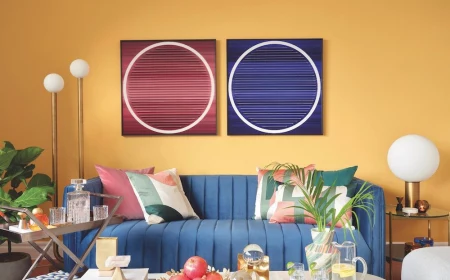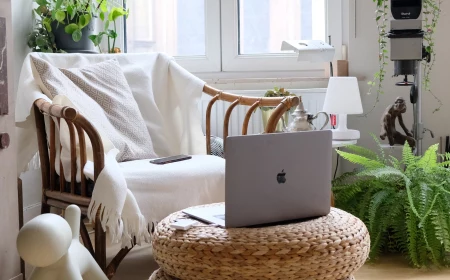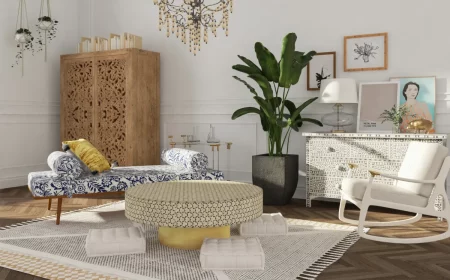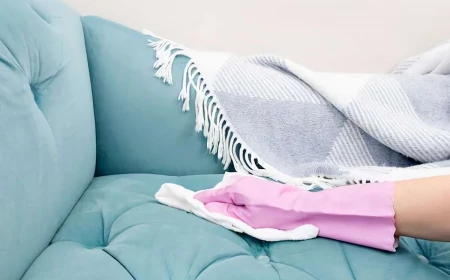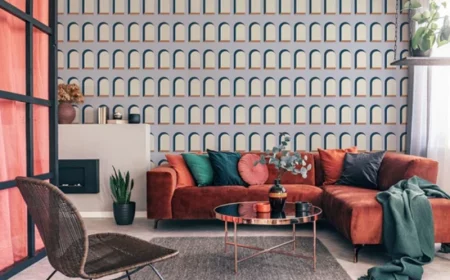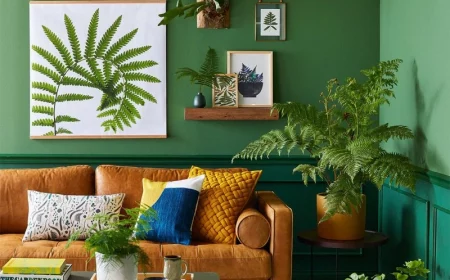Your Studio Apartment Doesn’t Have to Feel Small: A Pro’s Guide to Living Large
I’ve spent years neck-deep in the world of interior design, focusing on those small city apartments where every single inch is prime real estate. My very first solo project was a tricky 400-square-foot studio with some seriously awkward angles. That experience taught me something huge: making a studio work isn’t about finding clever boxes to hide your junk. It’s about creating a smart, comfortable, and truly functional home inside a single room. It’s less about fluffy pillows and more about being your own mini-architect.
In this article
So many people think of a studio as a temporary stepping stone, a compromise. But I see it as a masterclass in efficiency. A well-designed studio can feel more intentional and calming than a giant house with rooms you never even walk into. In this guide, we’re going to get into the nitty-gritty of what makes a small space feel great—and it goes way beyond just painting the walls white.
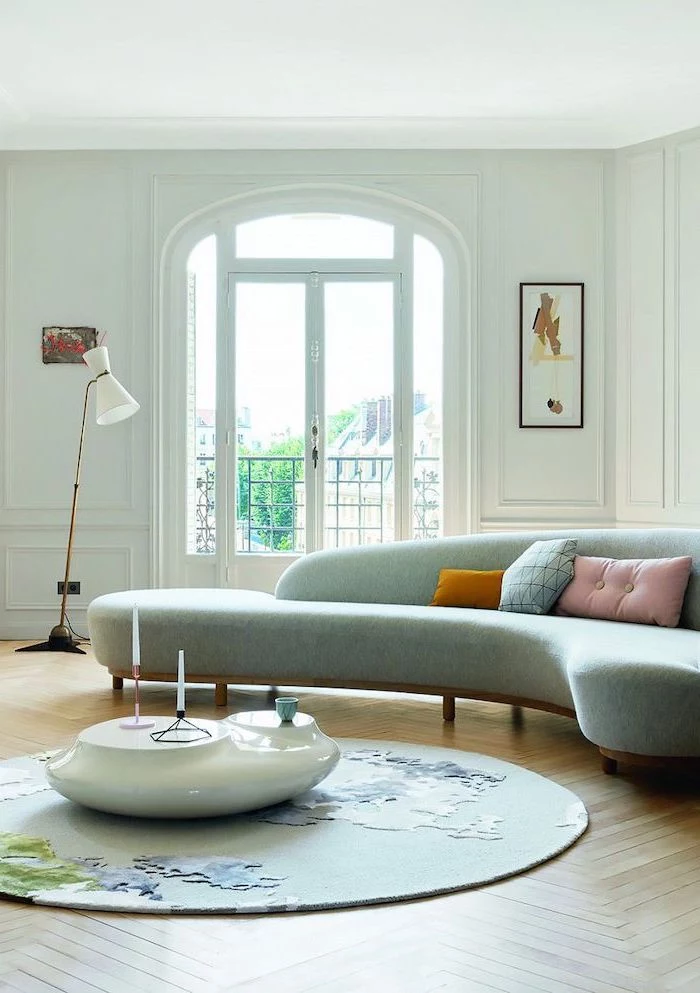
First, Let’s Talk About the Vibe of a Room
Before you even think about moving furniture, you need to understand why certain tricks work. It isn’t magic; it’s just a bit of science and human psychology. When you get the basics, you can stop randomly trying tips from the internet and start making real, impactful changes.
The Secret Language of Paint: LRV
You’ve heard “paint it white,” and sure, that helps. But the pros think in terms of Light Reflectance Value, or LRV. Every paint color has an LRV score from 0 (jet black) to 100 (pure, brilliant white), which tells you exactly how much light it bounces back into the room. For a small space, you really want to stick with paints that have an LRV of 60 or higher. For instance, a classic, bright off-white might have an LRV over 90, making it an absolute powerhouse for making a room feel airy. A trendy, mid-tone gray, on the other hand, could have an LRV of 40, meaning it soaks up light and can make the walls feel like they’re closing in.
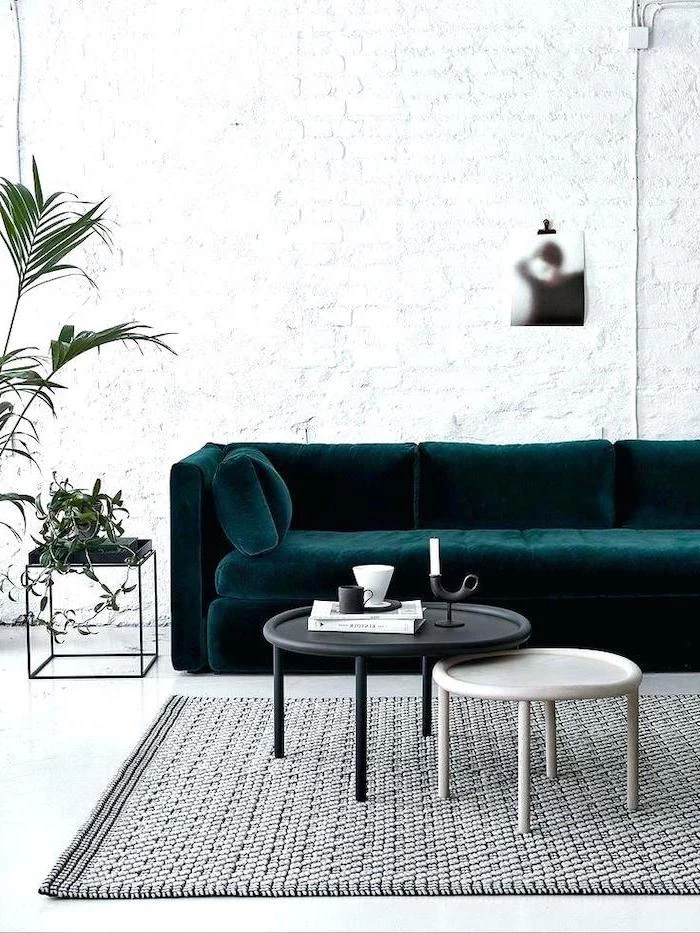
This doesn’t mean your place has to look like a hospital. You can find beautiful soft whites, pale grays, or light, dusty blues with high LRV scores. Just check the technical data sheet on the paint manufacturer’s website. A gallon of high-quality, high-LRV paint will run you about $50 to $80, and honestly, it’s the biggest bang-for-your-buck change you can make.
Protect Your Sightline!
When you walk into a room, your brain does a super-fast calculation. If your eyes can travel smoothly from the door to the furthest point—usually the window—your brain registers the whole area as being bigger and more open. I call this protecting the primary sightline. What does that mean for you? Don’t stick a tall, solid bookshelf or a clunky wardrobe right in that path. It’s like putting up a visual wall.
Instead, opt for a low-profile sofa, a see-through glass coffee table, or any piece of furniture with legs that lift it off the floor. Even better, place a large mirror on the wall opposite the entrance. It keeps the path clear and reflects light and the view, creating a brilliant illusion of depth.
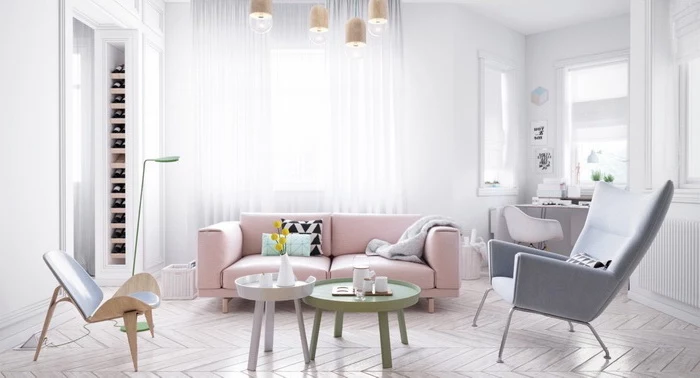
Quick Win: Go stand in your doorway right now. Is there a tall piece of furniture blocking the direct view to your main window? Try moving it somewhere else for just one day. I promise you’ll feel the difference.
The ‘Caveman Brain’ Theory: Prospect and Refuge
This is a cool concept from psychology. Deep down, humans want two things in a space: a clear, open view (prospect) and a small, protected, cozy spot to retreat to (refuge). A great studio apartment nails both. The main living area should feel open and airy, while your sleeping area should feel like a safe, enclosed little nest. Getting this balance right is the key to feeling comfortable, not just having a space that looks good. A bed tucked into a corner or an alcove just feels more restful than one floating in the middle of the room.
Creating Zones (When You Don’t Have Walls)
Okay, so how do you create that “refuge” for your bed or a distinct kitchen area? You have to fake the walls using clever visual cues. This is where you can get really creative, but a little discipline goes a long way.
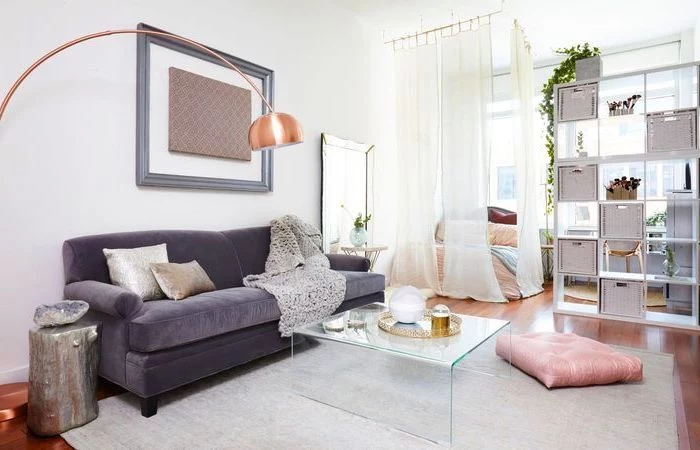
Let the Floor Do the Talking
One of the most powerful ways to define a zone is by changing the flooring. For example, you could use a durable, large tile in the kitchen area and then switch to a warm wood-look vinyl or laminate for the living and sleeping space. It sends a clear signal to your brain: “this is the kitchen,” and “this is the living room.”
Heads up for renters! You obviously can’t tear out your floors. But you can get the same effect. A large area rug (and I mean LARGE) in the living area creates a powerful boundary. You could also look into high-quality, removable peel-and-stick flooring for the kitchen. Modern versions look surprisingly good and can be removed when you move out.
The Power of a Platform
If you’re lucky enough to have high ceilings (think 9 feet or more), a raised platform for your bed is an absolute game-changer. We’re not just talking about a box for your mattress; this is a serious structural element. A platform is usually built about 18 to 24 inches high, which is the perfect height to build massive storage drawers into the base. Say goodbye to your dresser!
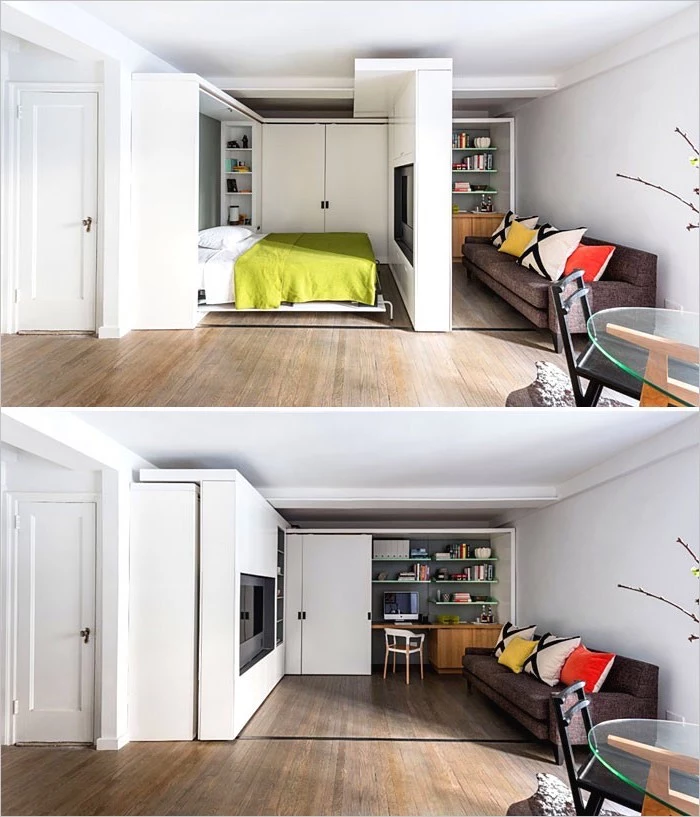
But a word of caution: This is NOT a beginner DIY project and it’s almost always a no-go for renters. For homeowners, it’s a fantastic investment, but you need a pro to build it safely. Expect a custom-built platform to range anywhere from $2,500 to $7,000, depending on the size, materials, and labor costs in your area.
Layer Your Lighting
A single, sad light fixture in the middle of the ceiling is a studio-killer. It casts weird shadows and makes everything feel flat and uninviting. You need to think in three layers:
- Ambient Light: This is your general, all-over light. Instead of one central fixture, think about a few recessed lights or a modern track lighting system. Stick to a warm white color temperature (around 2700K-3000K) for a cozy feel.
- Task Light: This is focused light for getting things done. Under-cabinet LED strips in the kitchen are non-negotiable. Add a reading lamp by your sofa and a bright light for your desk. These should be a bit brighter and cooler (around 3500K).
- Accent Light: This is the fun layer! It’s the light you use to highlight art, a plant, or a cool architectural feature. It adds depth and makes your space feel curated.
A quick pro tip: When buying bulbs, look for a high Color Rendering Index (CRI), preferably 90 or above. It means the light will show colors accurately, so your stuff looks vibrant instead of washed out. If you’re looking at adding recessed lights, hiring a licensed electrician to install 4-6 of them will likely cost between $600 and $1,500, but it’s a worthy investment in the feel of your home.
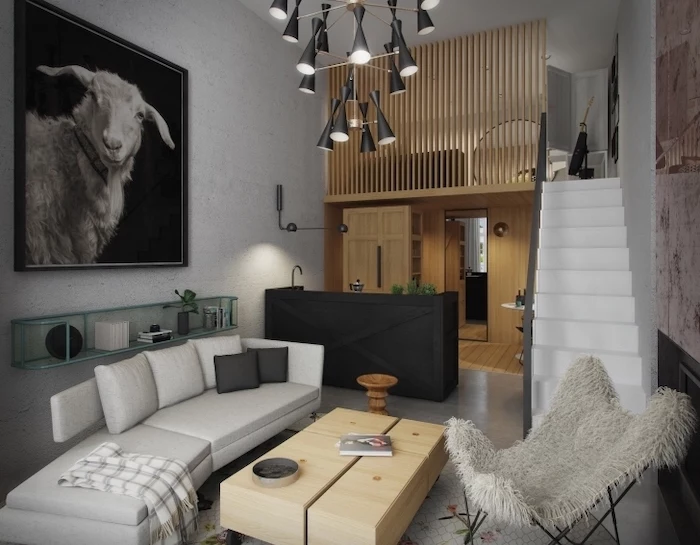
The Nitty-Gritty: Furniture and Storage
This is where most people get overwhelmed. The trick is to think like a curator, not a hoarder. Every single piece you bring in has to earn its spot.
The Myth of “Small” Furniture
Here’s a common mistake: filling a studio with a bunch of tiny furniture. It sounds logical, but it actually makes the space feel cluttered and chaotic, like a dollhouse. It’s often much better to use a few larger, well-proportioned pieces. A proper sofa (say, 72-84 inches long) can anchor the living area far better than a dinky loveseat and a couple of small chairs. Look for pieces with clean lines and, most importantly, raised legs. Being able to see the floor underneath the sofa makes the room feel way more open. (Good to know: Brands like Article, Joybird, and even collections from West Elm or CB2 are great places to find sofas with this kind of leggy, apartment-friendly scale).
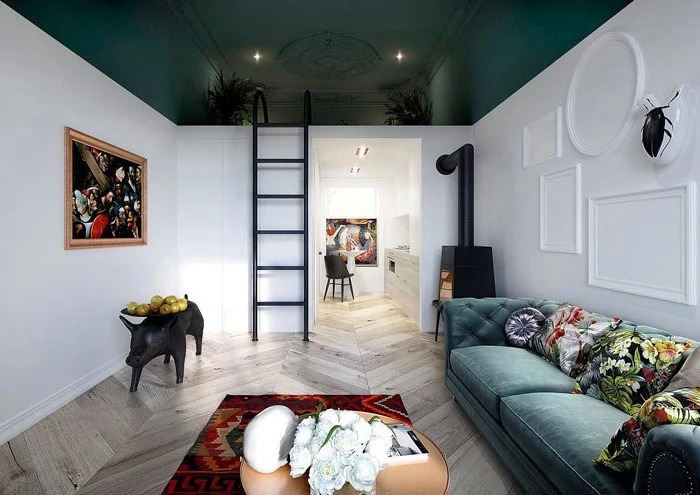
Choosing Your Multi-Functional Hero
Multi-functional furniture is your best friend in a studio, but not all pieces are created equal. Let’s break down the big three sleeping solutions:
- The Sofa Bed: This is the go-to for a reason. It’s a sofa by day, a bed by night. The downside? They’re often not the most comfortable for sleeping on every single night. They’re fantastic if you prioritize your living space and only need a guest bed occasionally. A good one will set you back anywhere from $800 to $3,000.
- The Murphy Bed: This is the true space-saving champion. The bed folds up into a cabinet or against the wall, leaving your floor completely open. Because it uses a real mattress, it’s perfect for daily use. The catch is the cost and installation. They often start around $2,000 (plus installation) and go way up from there.
- The Loft Bed: Think of it as the adult version of a bunk bed. It lifts your bed up high, creating a ton of usable space underneath for a desk, a small sofa, or storage. This is a brilliant solution if you have high ceilings (at least 9 feet is a must!) and you don’t mind a climb. You can find simple metal frames for a few hundred dollars or invest in a sturdier custom build for a few thousand.
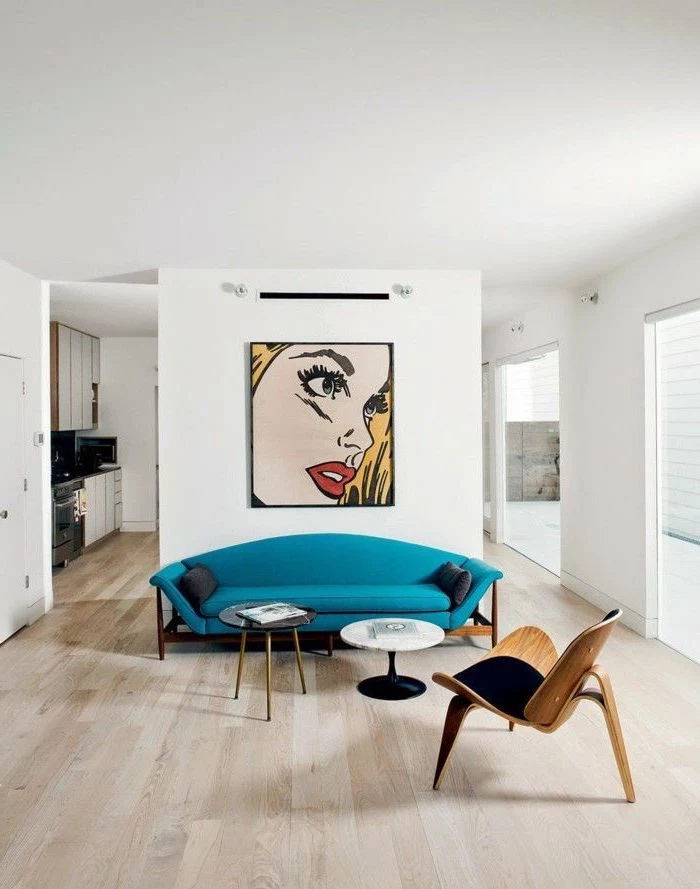
Your Studio Starter Kit (A Rough Guide)
Feeling overwhelmed? Here’s a basic shopping list to get you started for a typical 400 sq. ft. space, with ballpark prices to keep things real:
- One 78″ Sofa on Legs: The anchor of your living space. Budget: $800 – $2,000
- One Large Area Rug (at least 8’x10′): This is crucial for defining your living zone. Don’t skimp on size! Budget: $300 – $900
- A Narrow C-Table: It can slide over your sofa arm to hold a drink or laptop, then tuck away. Budget: $50 – $150
- A Round Dining Table (30″-36″): Round tables take up less visual space and have no sharp corners to bump into. Budget: $200 – $600
- Vertical Bookshelf or Ladder Shelf: Draw the eye upward and use that wall space. Budget: $100 – $400
- A Large Mirror (at least 40″ tall): The oldest trick in the book, because it works. Budget: $150 – $500
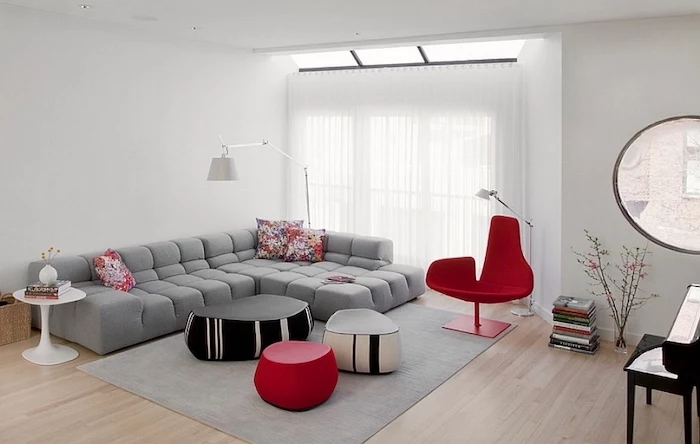
Finally, a Few Common Mistakes to Avoid
I see these all the time, and they’re so easy to fix.
- The Postage Stamp Rug. A tiny little rug floating in the middle of your floor makes the room look tiny. Go bigger than you think! At a minimum, the front legs of your sofa and any chairs should be on the rug.
- Ignoring Vertical Space. Your walls are your best asset. Use tall bookshelves, floating shelves, and art hung a little higher to draw the eye up and make the ceilings feel taller.
- Blocking Natural Light. Don’t put a huge, dark piece of furniture right in front of your only window. Opt for light, airy curtains (or no curtains!) to let in as much sun as possible.
At the end of the day, designing a studio is a puzzle, but it’s a fun one. It forces you to be intentional about what you own and how you live. And when you get it right, you’ll have a cozy, functional, and beautiful space that’s perfectly, uniquely yours.
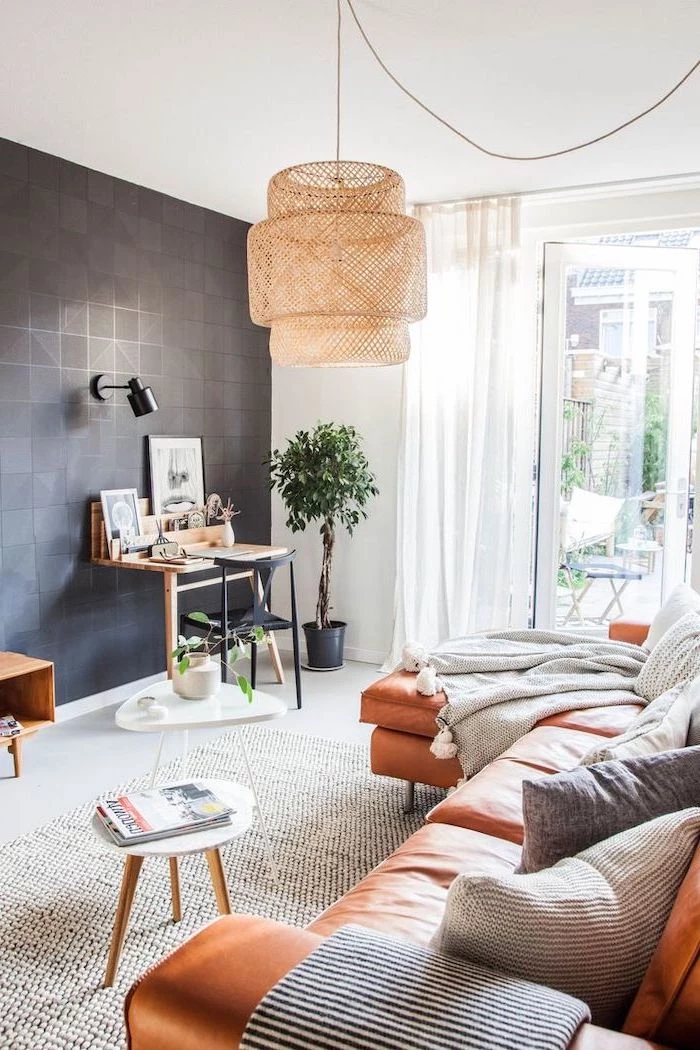
Inspiration Gallery
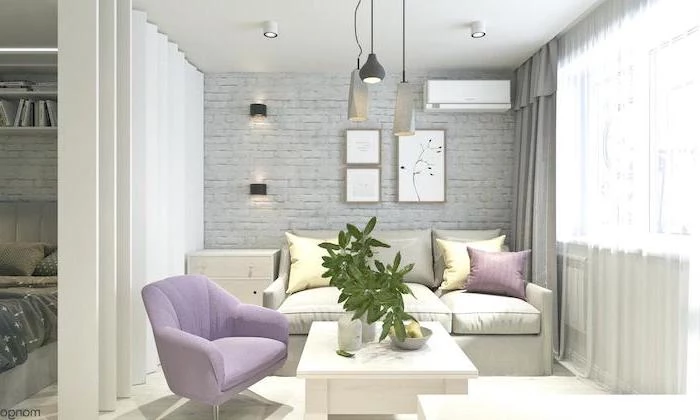
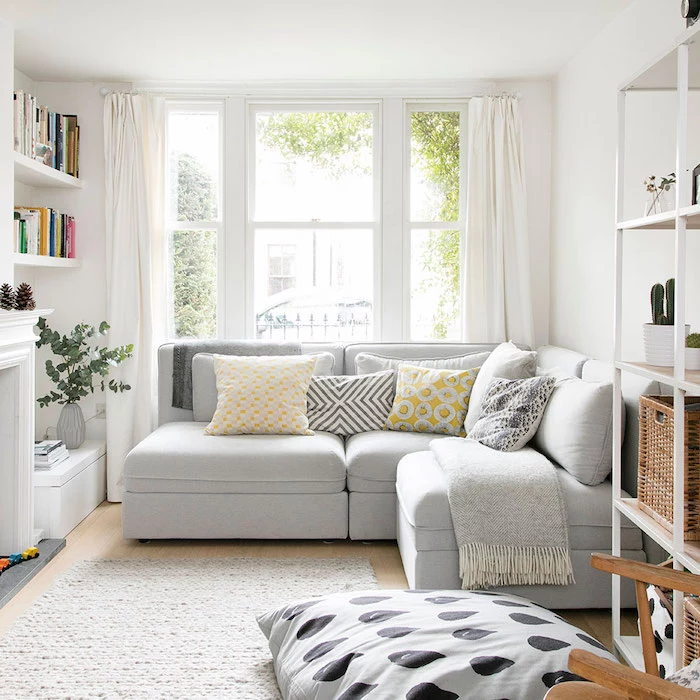
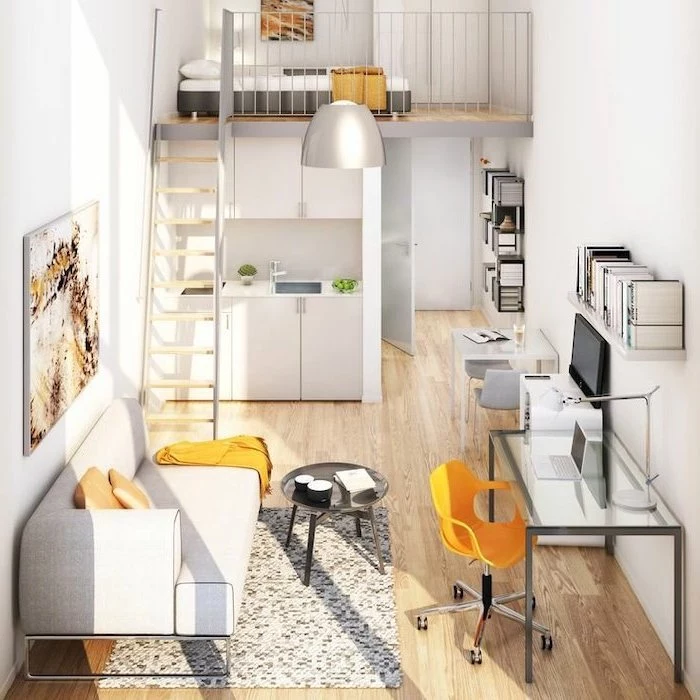
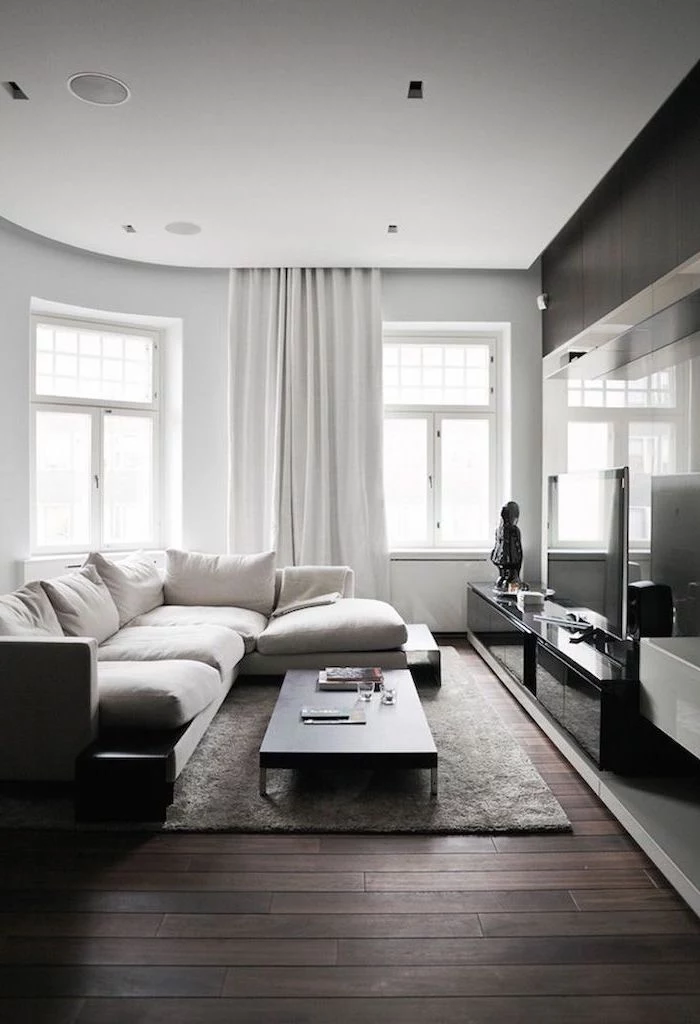
Go See-Through: When every piece of furniture occupies visual real estate, trick the eye by making some of it disappear. Acrylic or lucite furniture, like a waterfall console table or a “ghost” chair, allows light to pass through, making the room feel less crowded.
Go Solid: Opaque furniture, especially with built-in storage, is better for hiding clutter. A solid wood coffee table with drawers is more practical than a glass one if you need to stash remotes, coasters, and magazines.
The best approach is often a mix of both.
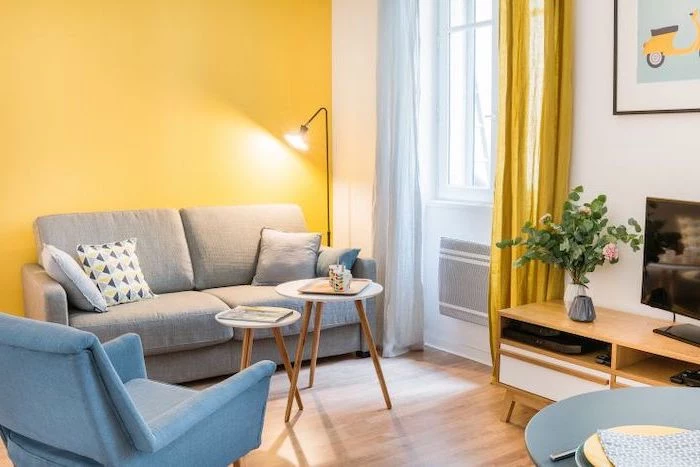
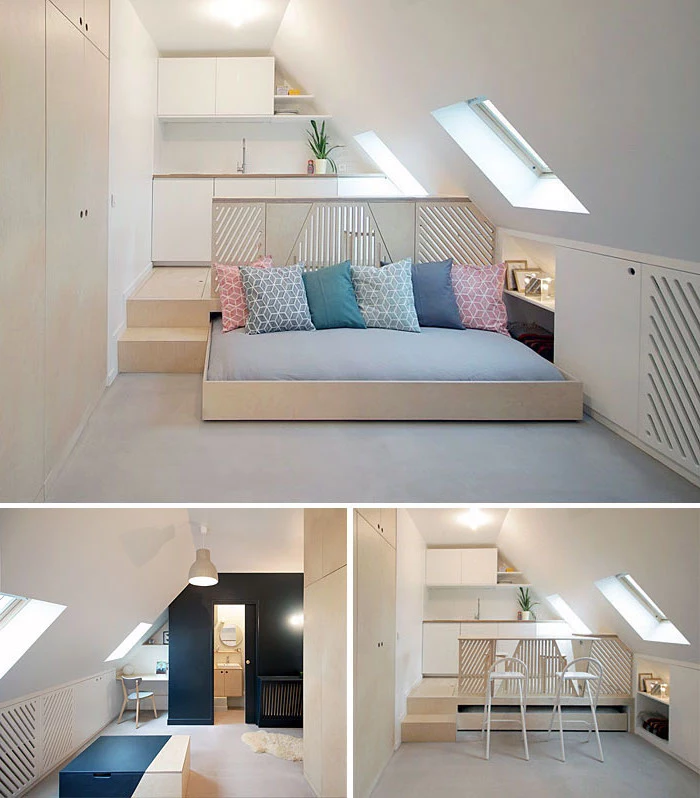
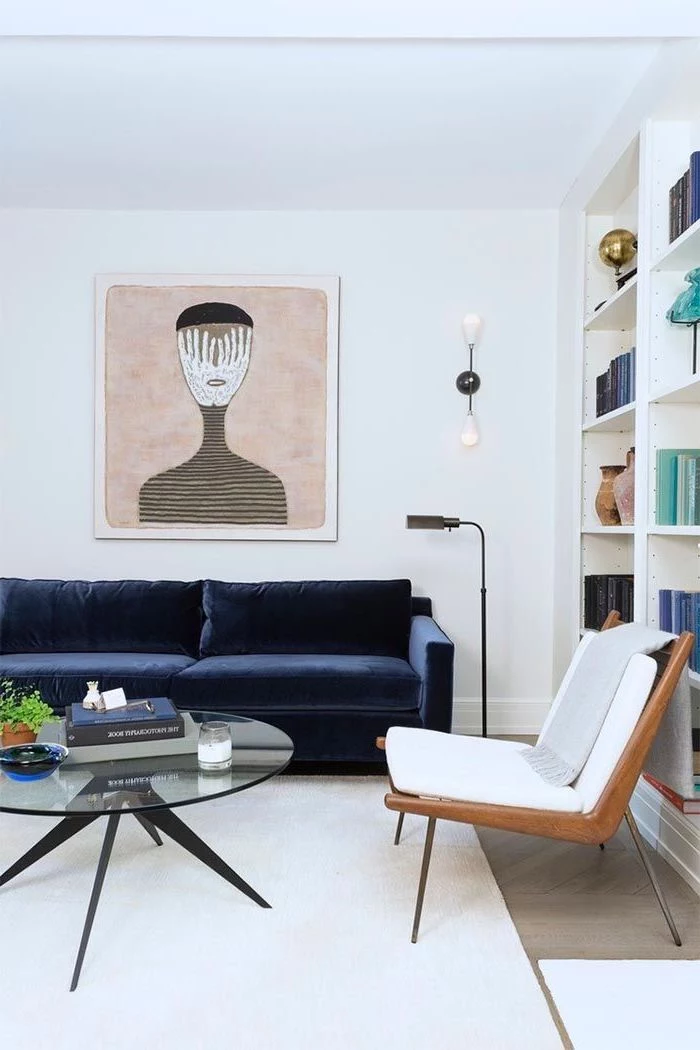
A study from the Princeton University Neuroscience Institute found that a cluttered environment restricts your ability to focus and process information.
This isn’t just about tidiness. In a studio, your living space is also your workspace, your dining space, and your relaxation space. Constant visual clutter means your brain is never truly “off duty.” A smart storage system isn’t a luxury; it’s a necessity for mental clarity.
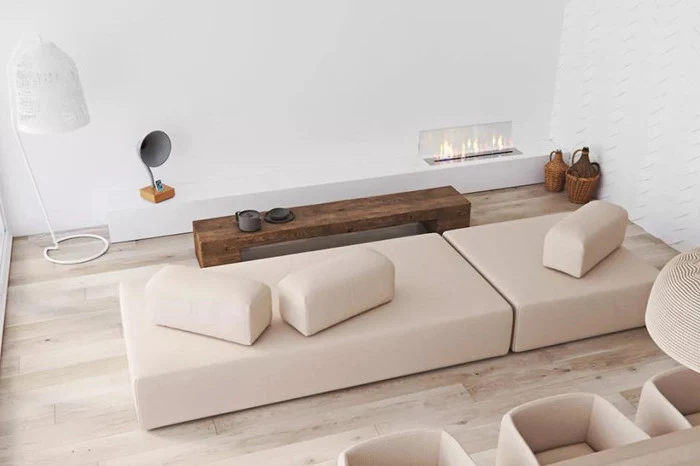
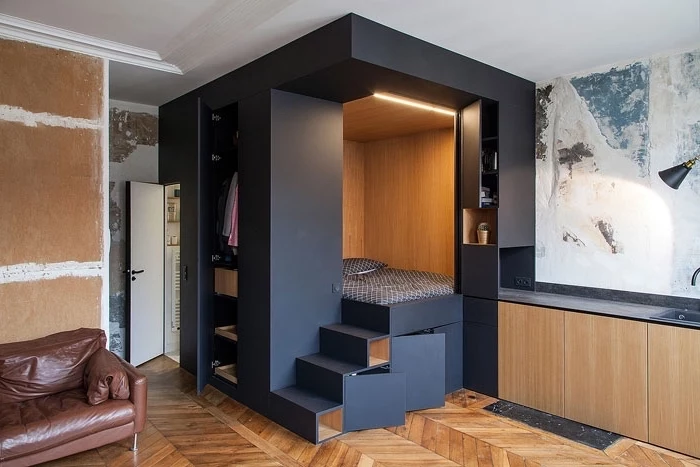
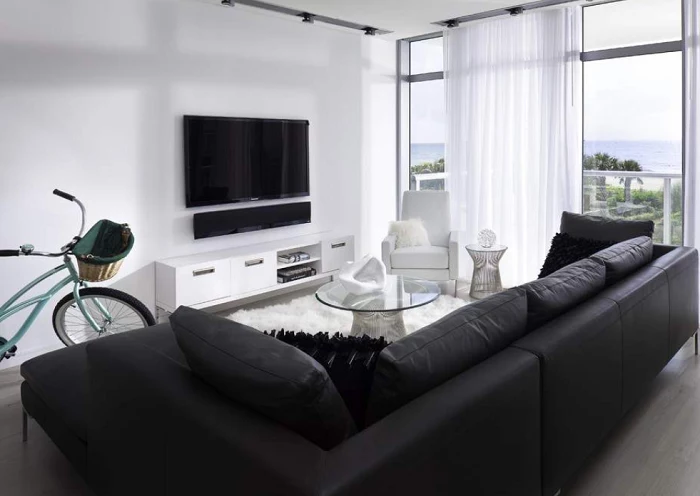
Don’t fall into the trap of using a small rug. It visually shrinks the floor plan. The pro move is to get the largest rug you can afford that fits the space, ensuring at least the front legs of all your main furniture pieces (sofa, chairs) are sitting on it. This creates a unified, intentional zone that makes the entire area feel larger and more cohesive.
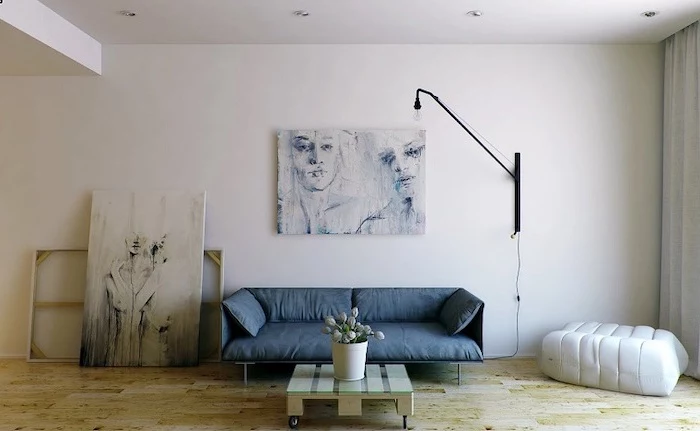
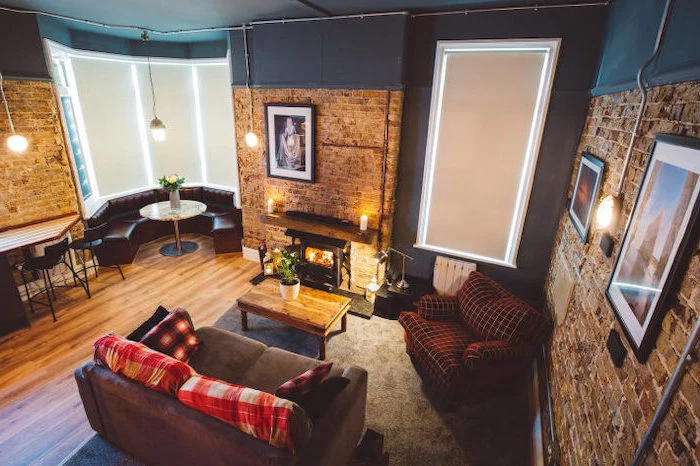
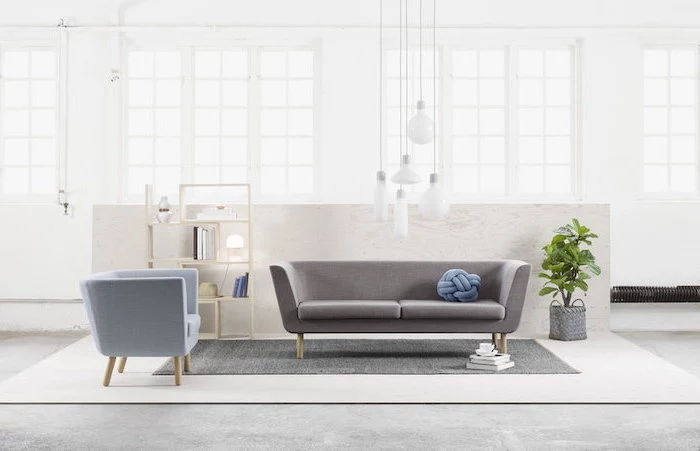
Can a sectional sofa ever work in a small studio?
Surprisingly, yes, but with major caveats. A small-scale, apartment-sized sectional can actually be a space-saver compared to a separate sofa and armchair, as it neatly tucks into a corner. Look for models with thin arms and raised legs to keep the look light. Brands like Article and Floyd offer great apartment-sized options. Avoid overstuffed, bulky designs at all costs.
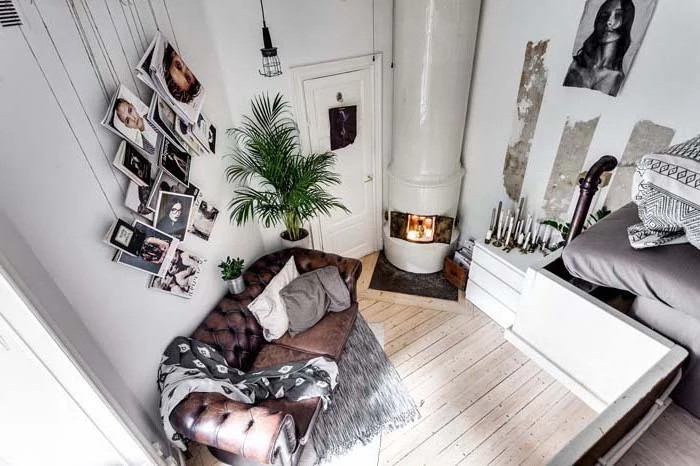
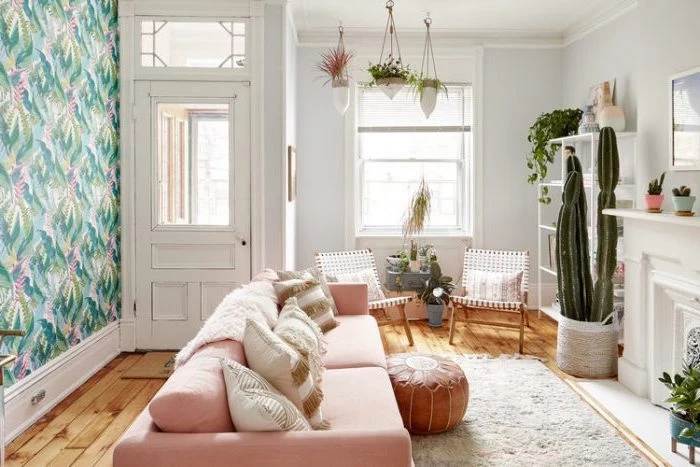
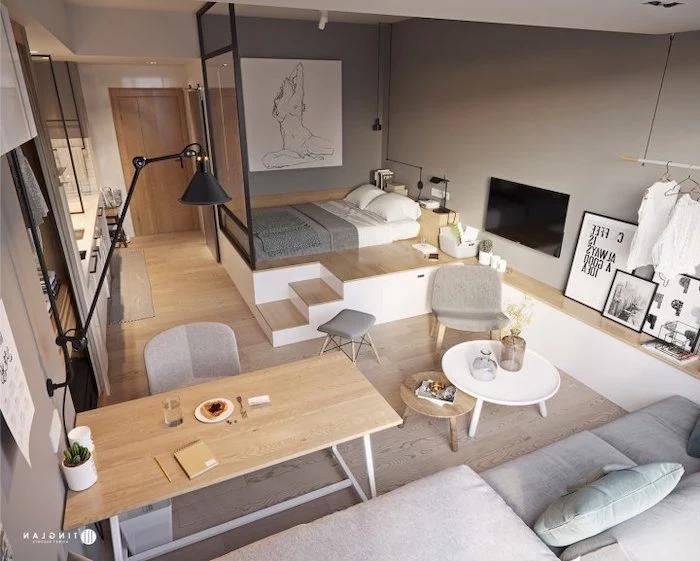
Important point: Every major piece of furniture should do at least two jobs. A coffee table should lift to become a dining or work surface (like a model from Wayfair or a higher-end Expand Furniture piece). An ottoman must have hidden storage. Your bed frame should incorporate drawers. This isn’t just a clever trick; it’s the fundamental principle of successful studio living.
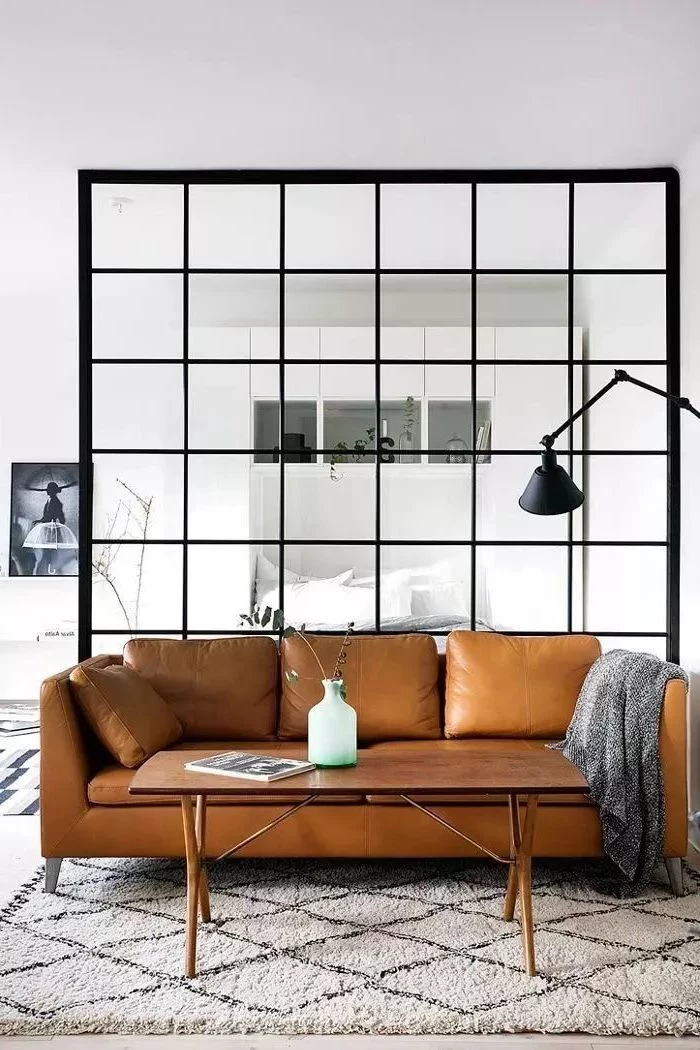
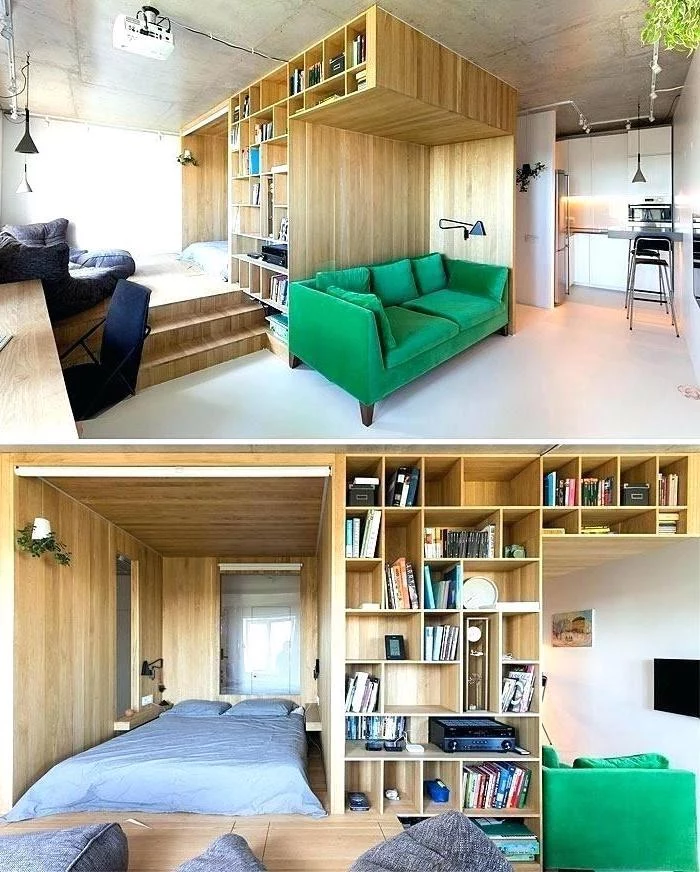
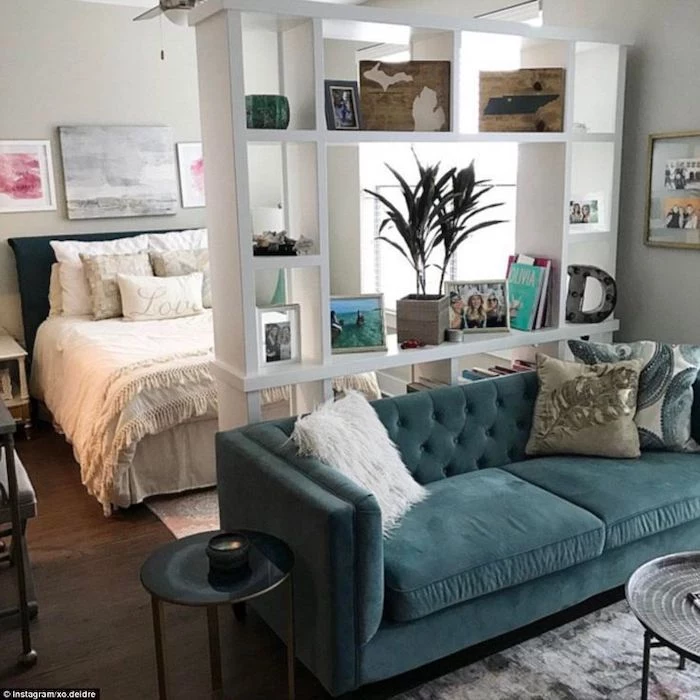
- Create a sense of grandeur, even with low ceilings.
- Draw the eye upward, making the room feel taller.
- Free up valuable floor space.
The secret? Go vertical. Use tall, narrow bookshelves, install wall-mounted shelving that goes almost to the ceiling, and hang curtains higher and wider than the actual window frame. This creates vertical lines that fool the eye.
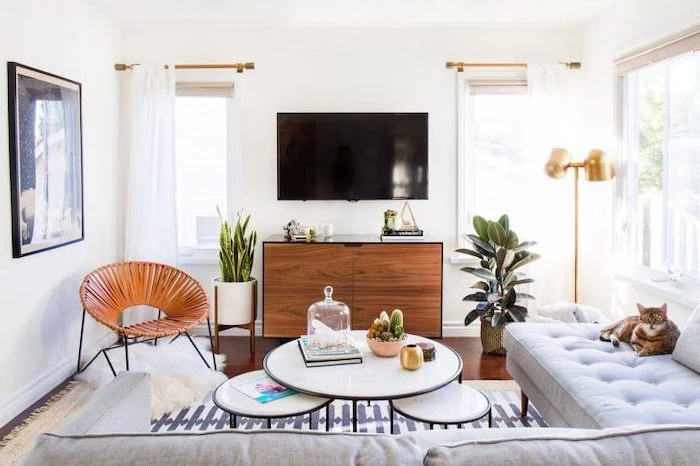

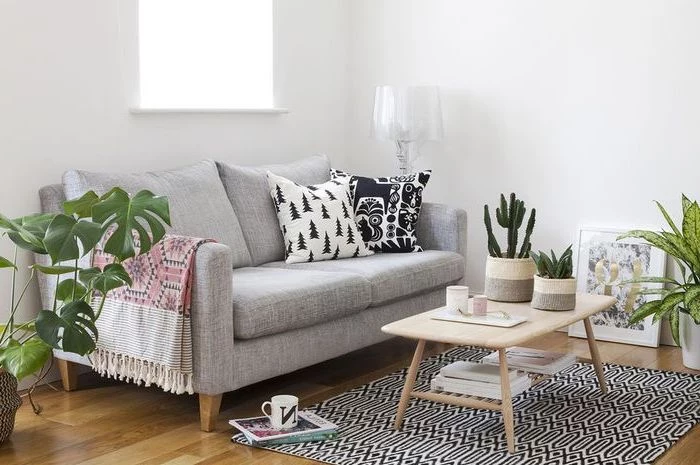
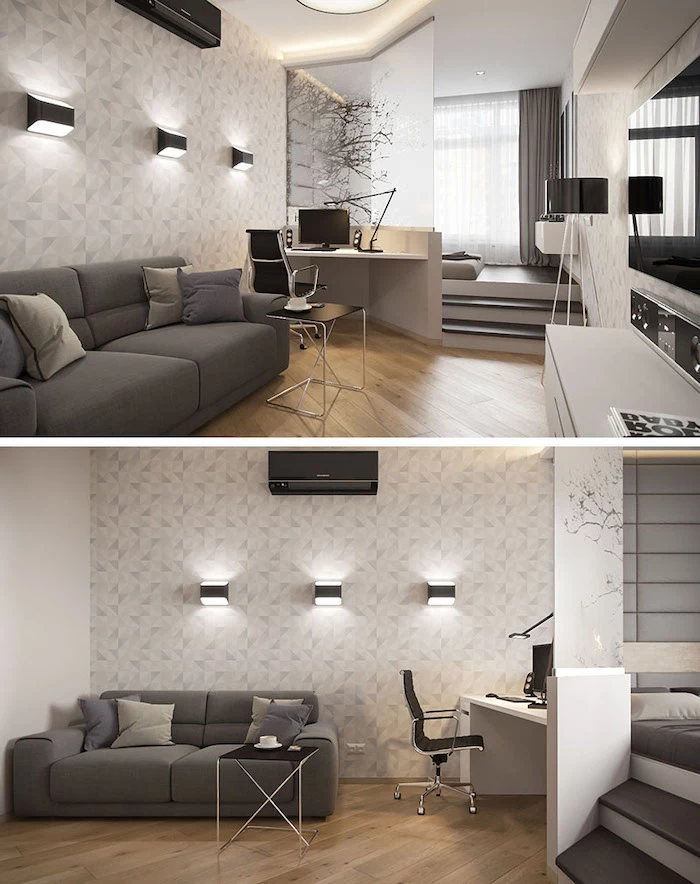
Think about your lighting in three layers to add depth and create mood.
- Ambient: Your main overhead light. A stylish flush mount or a modern track light system is better than a low-hanging chandelier that eats up headspace.
- Task: Focused light for activities. This means a reading lamp by your sofa, under-cabinet lighting in the kitchenette, and a good desk lamp.
- Accent: The fun part! Use this to highlight art, a plant, or architectural details. A small, directional spotlight can completely change the vibe of a corner.
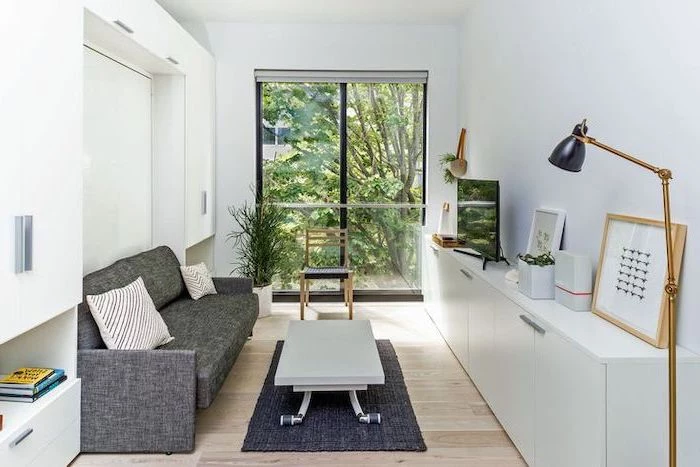
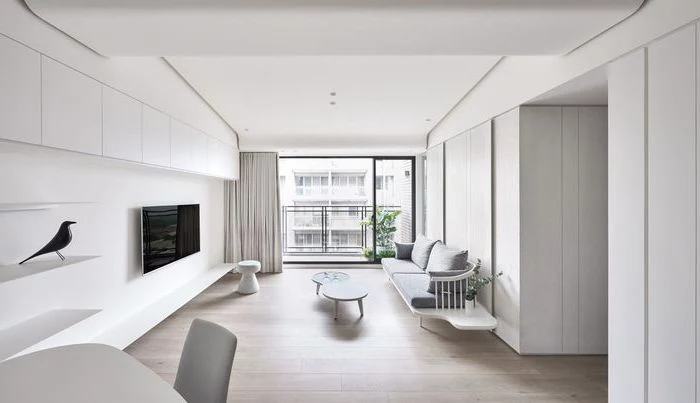
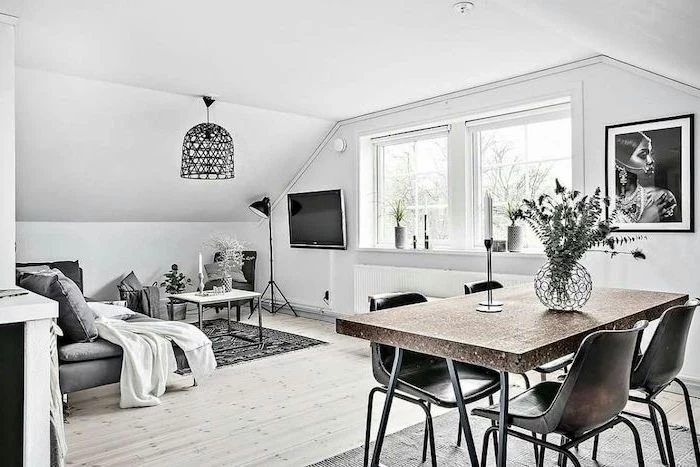
When you can see your entire home from one spot, defining zones is critical. One of the most subtle yet effective ways to do this is with scent. Use a light, energizing reed diffuser (like citrus or mint) in your workspace area and a calming scent (like lavender or sandalwood) from a candle or essential oil burner near your bed. This olfactory cue helps your brain switch modes, even when the scenery doesn’t change.
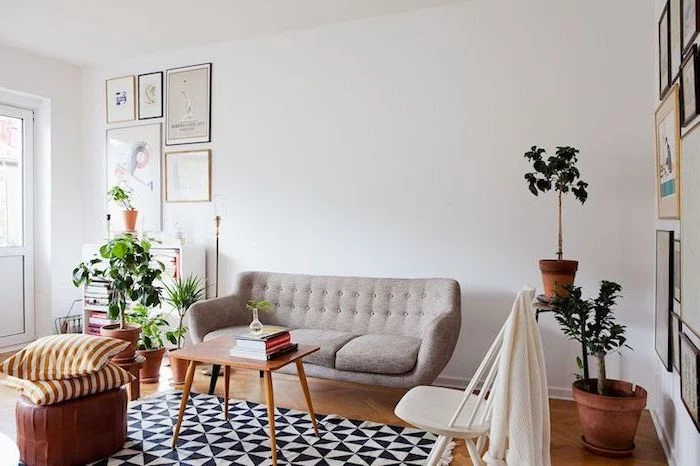
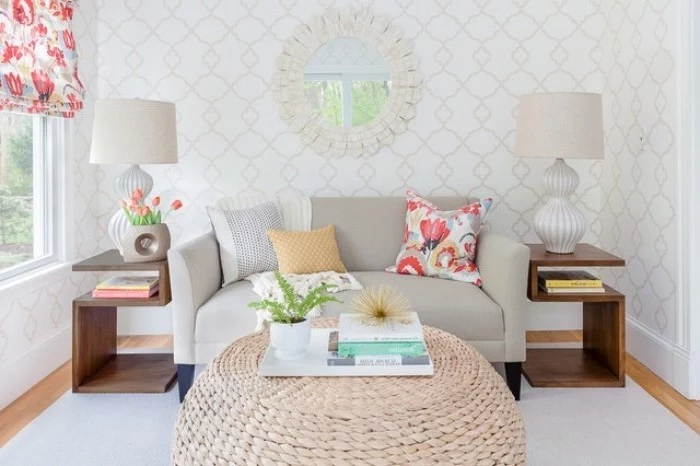
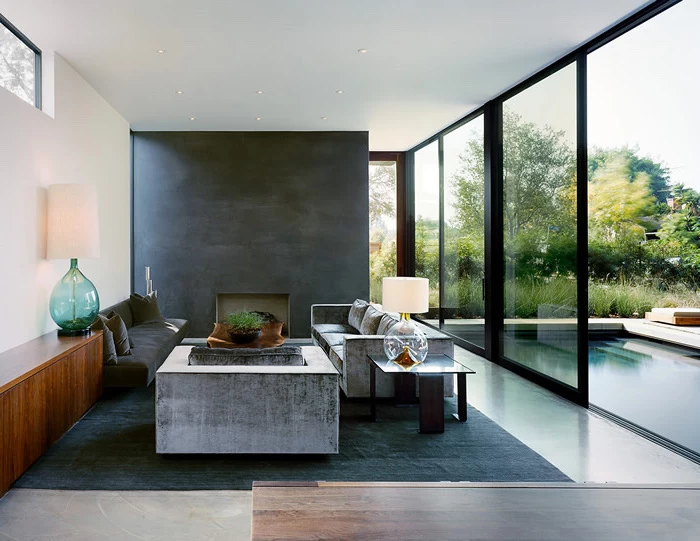
Room Divider Screen: Lightweight, flexible, and often decorative. Perfect for temporarily hiding a messy corner or creating a soft boundary for a sleeping nook. It offers privacy but little in the way of function.
Bookshelf Divider: A workhorse like the IKEA KALLAX. It firmly defines a space while providing double-sided storage and display opportunities. It’s less flexible but far more practical.
For pure function, the bookshelf wins. For flexibility and aesthetics, choose the screen.
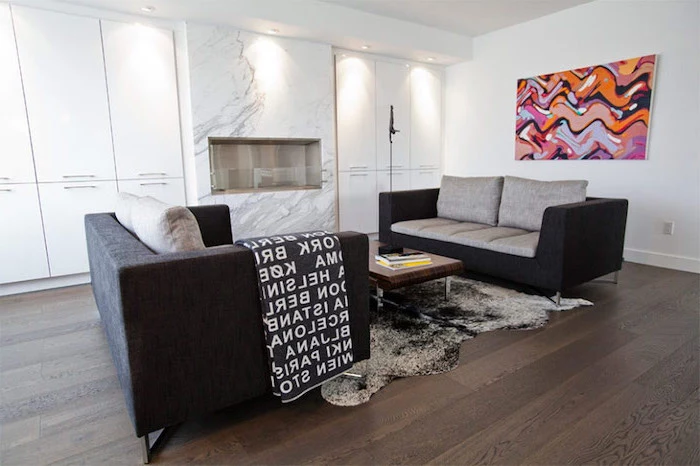
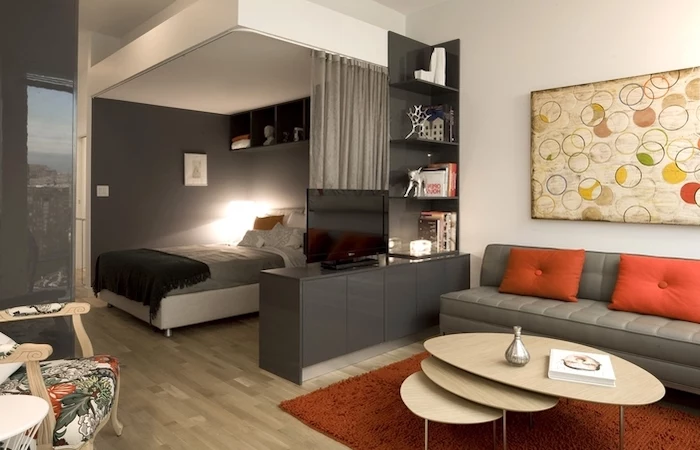
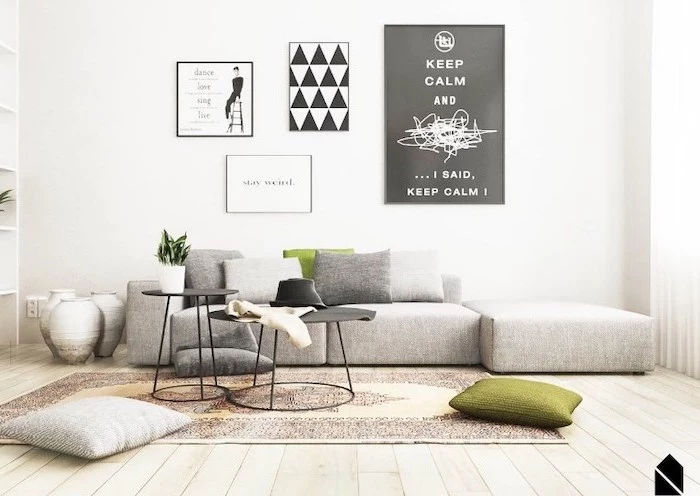
- Keep your work-from-home setup from taking over your living space.
- Ensure you can mentally “clock out” at the end of the day.
- Maintain a clutter-free zone for relaxation.
The solution? The ‘cloffice.’ Convert a closet into a mini-office. Install a floating desk, add some shelving and task lighting, and you have a dedicated workspace that can be completely hidden away by simply closing the door.
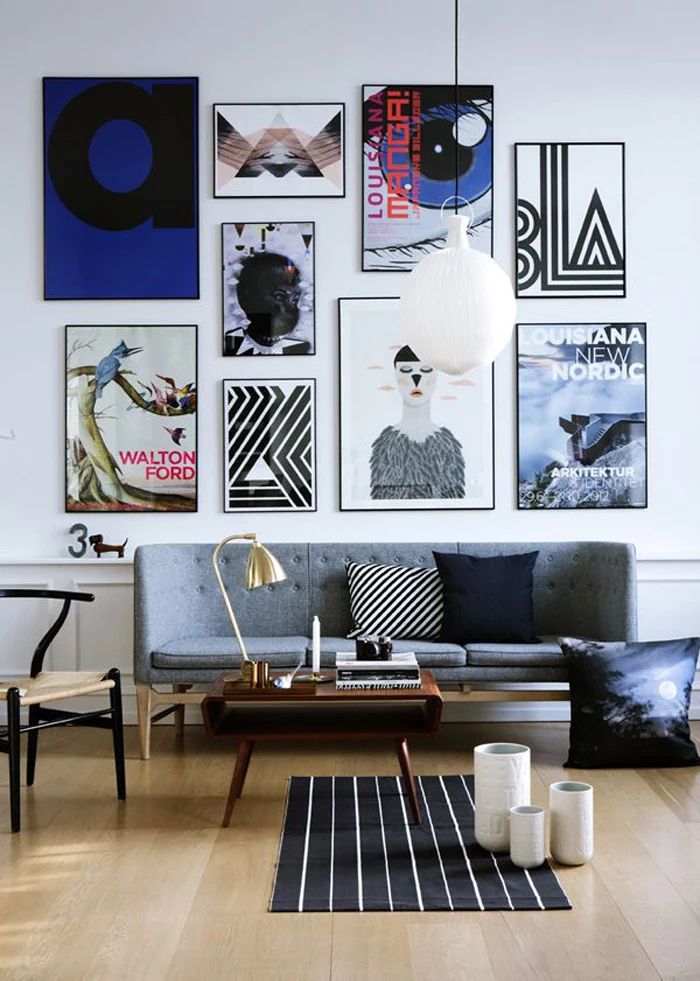
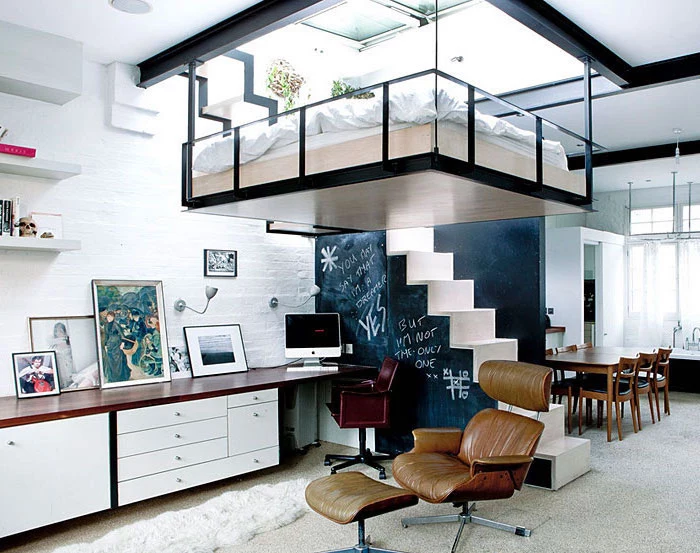
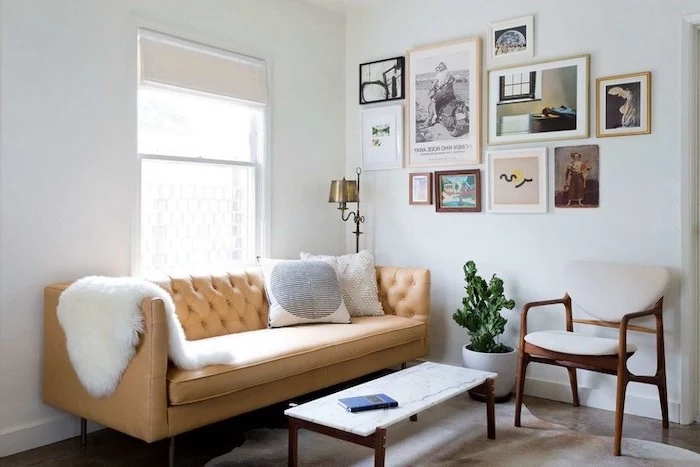
Mirrors can make a room feel up to twice its actual size.
But placement is everything. Don’t just hang one randomly. Position a large, floor-length mirror, like the popular Infinity Floor Mirror from CB2, on a wall opposite your main window. It will not only create an illusion of depth but also bounce natural light all around the room, amplifying the effect discussed in the LRV section.
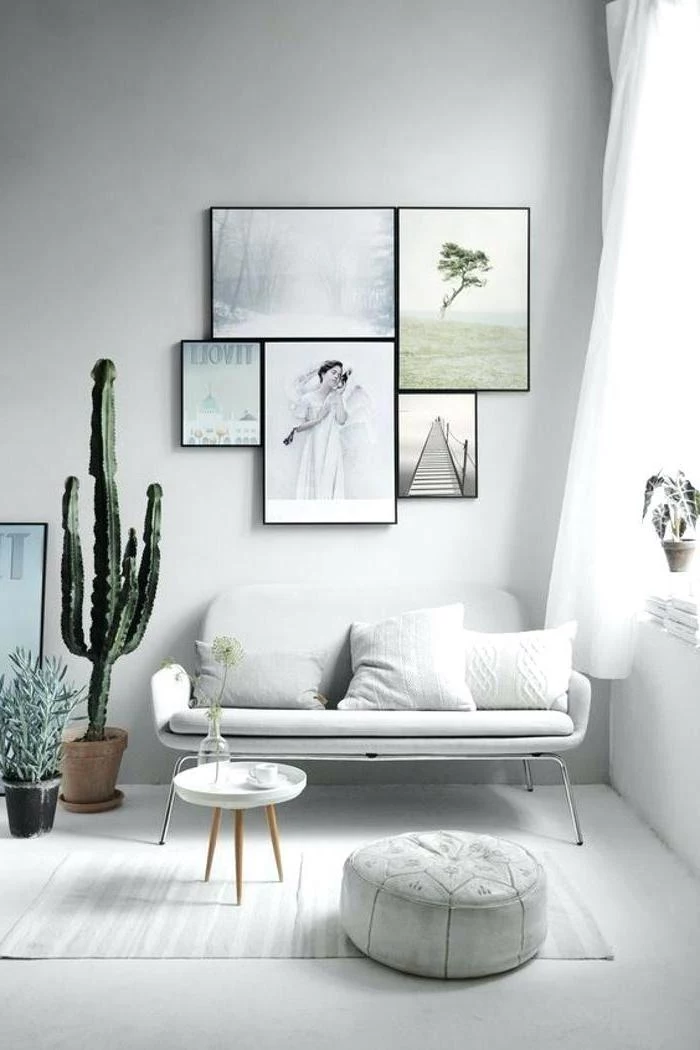
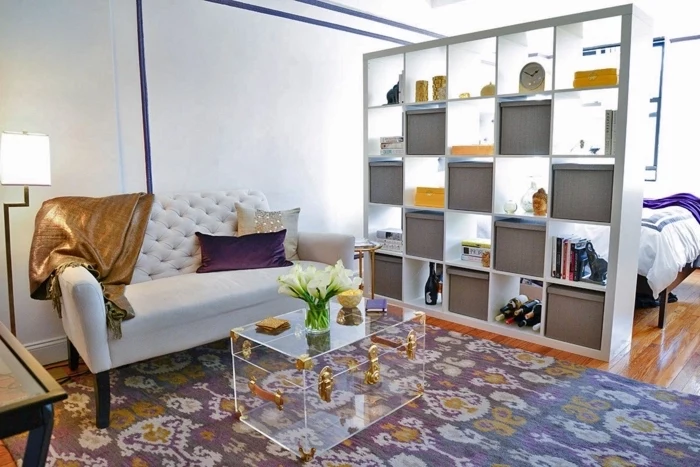
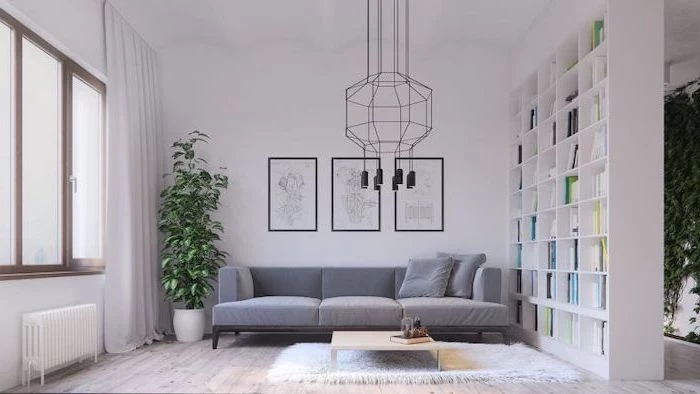
Think in curves. A round dining table (even a small bistro one) or a circular coffee table allows for better traffic flow than a sharp-cornered rectangular one. There are no corners to bump into, and they visually soften a room dominated by the straight lines of walls and cabinetry. This simple swap can make navigating your studio feel much more fluid.
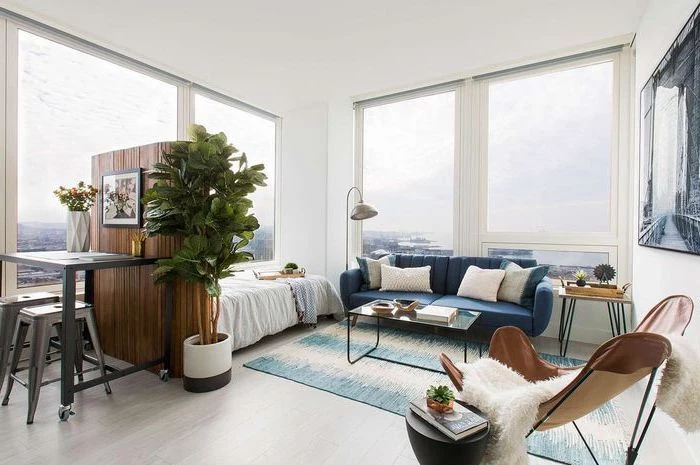

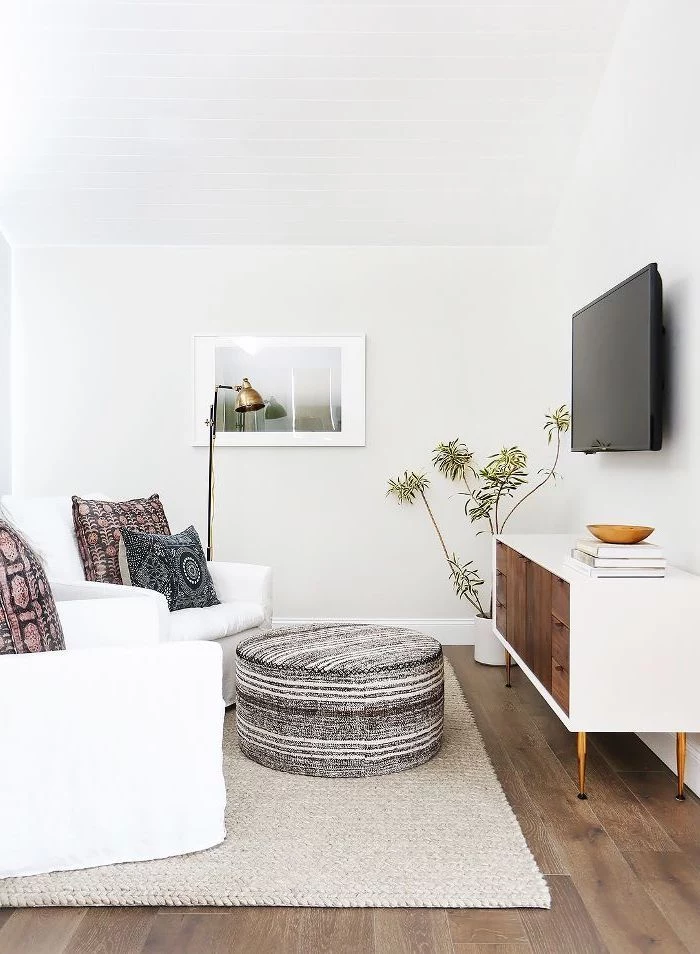
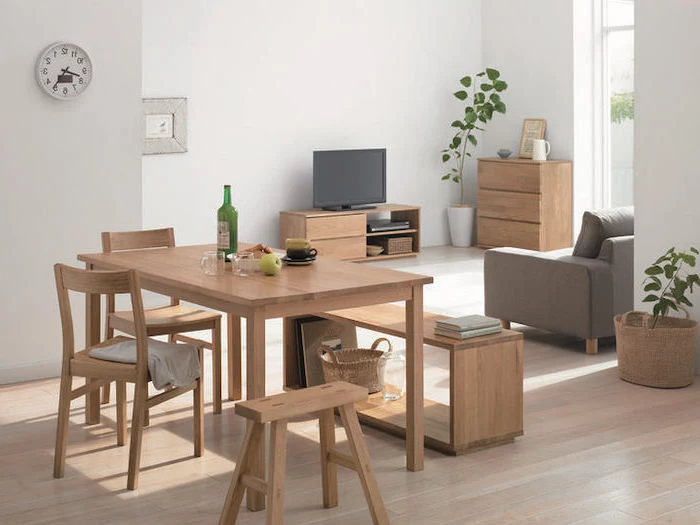
What’s the one piece of furniture worth splurging on in a studio?
Your sofa. You’ll be using it for sitting, lounging, entertaining, and maybe even sleeping. Don’t skimp. Invest in a high-quality, comfortable, and durable piece with a timeless design. A well-made sofa from a brand like Joybird or West Elm will anchor your entire space and withstand constant use, making your studio feel more like a permanent, luxurious home than a temporary stopgap.

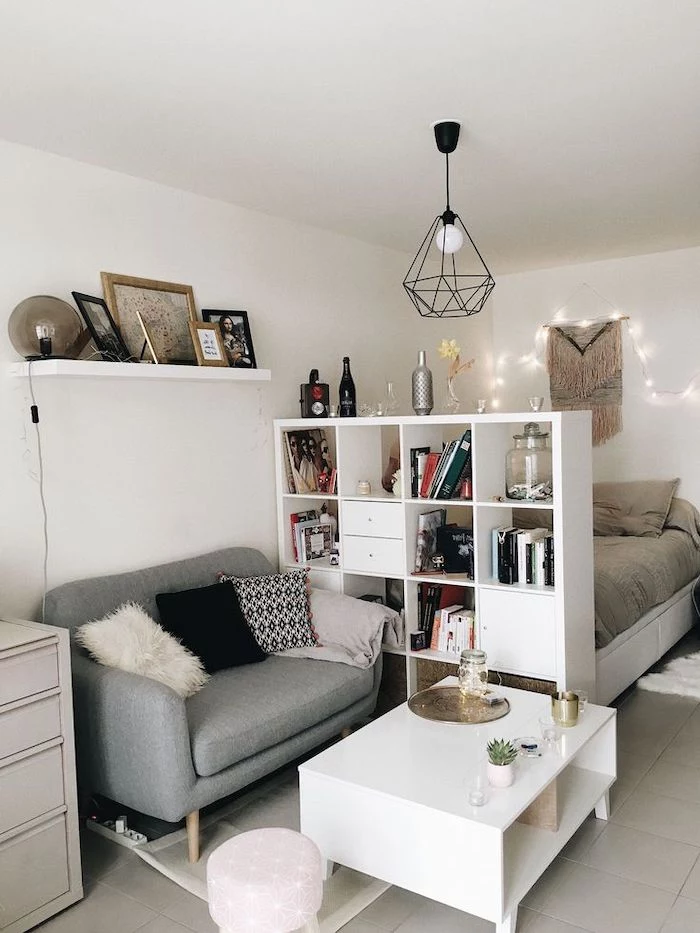
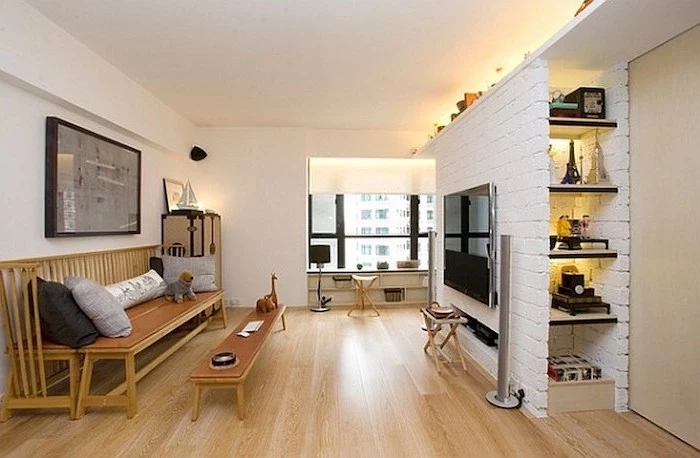
- An instantly cohesive and professional-looking space.
- A calming, harmonious atmosphere.
- Simplified decorating decisions.
The designer’s secret is the 60-30-10 rule. 60% of your room should be a dominant color (your walls, maybe your sofa). 30% should be a secondary color (curtains, accent chairs, bedding). 10% is your accent color (throw pillows, art, small accessories). It’s a foolproof formula for a balanced palette.
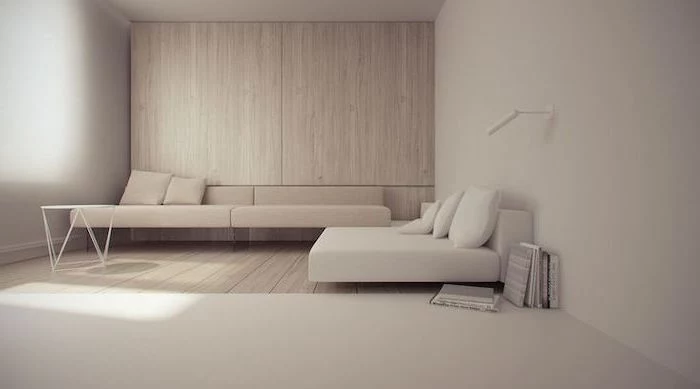

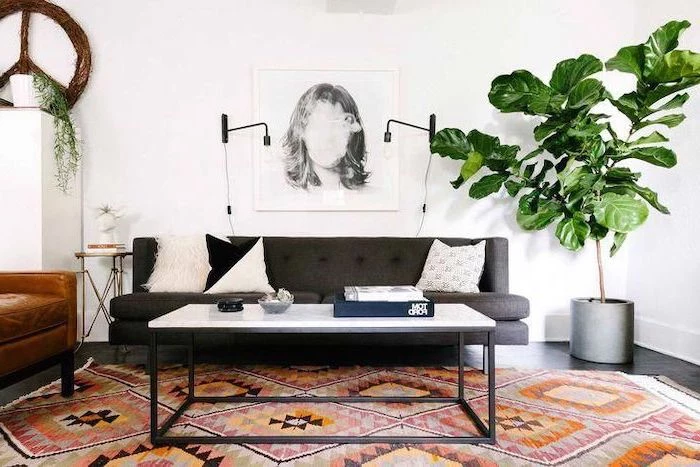
The critical mistake: Pushing all your furniture flat against the walls. It seems intuitive for saving space, but it actually makes a room feel static and smaller. Even pulling your sofa forward by just a few inches creates breathing room and casts shadows that suggest depth. Allow for ‘negative space’—the empty areas are just as important as the furnished ones for creating a sense of openness.

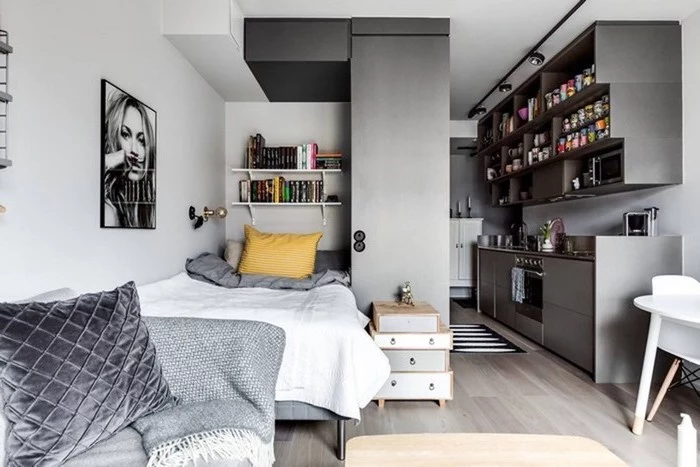
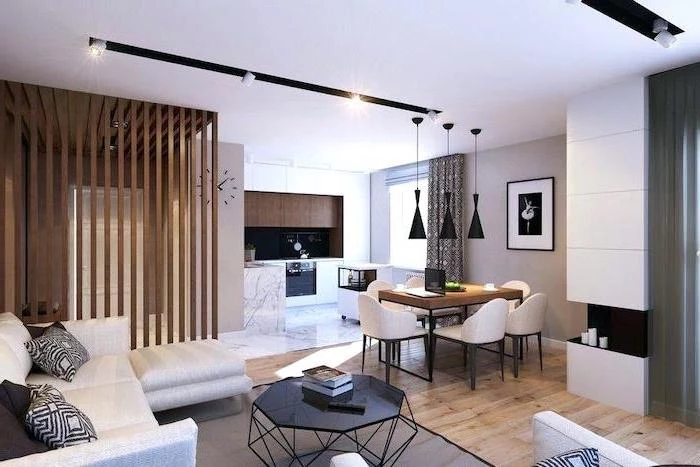
Your under-bed area is prime storage real estate. Make it count.
- Use wheeled containers for easy access to out-of-season clothing.
- Vacuum-sealed bags are your best friend for bulky items like duvets and extra pillows.
- Flat, portfolio-style boxes are perfect for documents or artwork.
- Look for bed risers that discreetly add several extra inches of clearance.
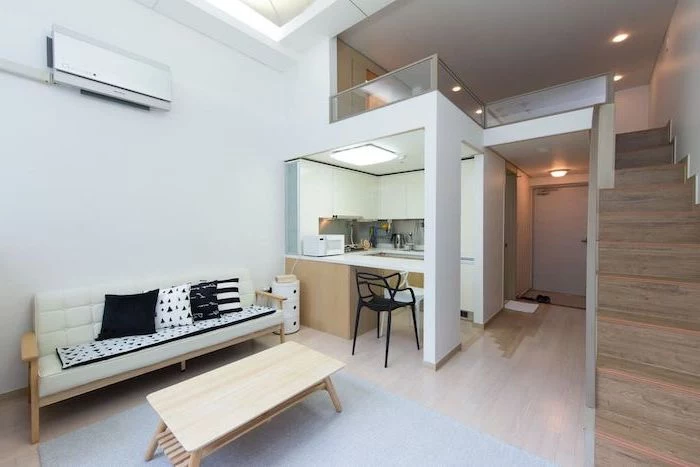
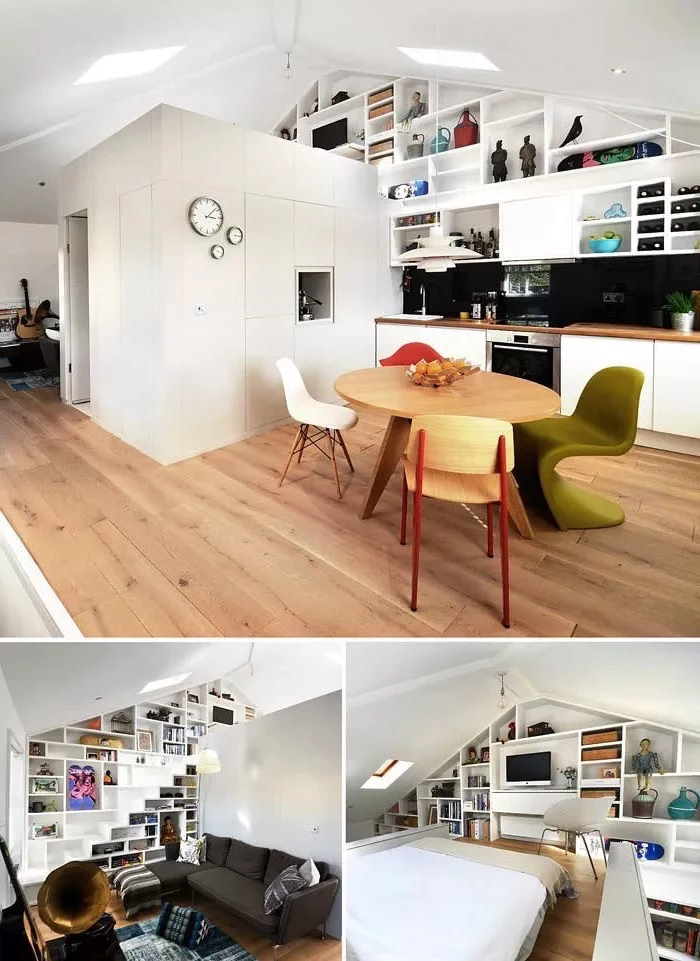
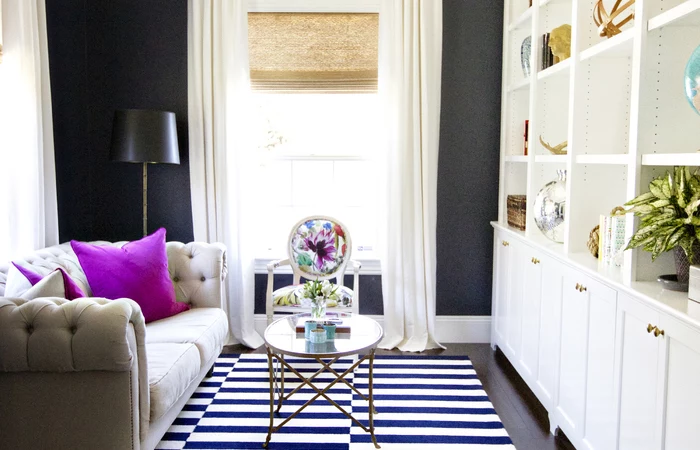
The right textiles can transform the feel of a studio from a sterile box to a cozy retreat. Here’s how to use them:
- Texture is key: Mix different textures to add richness. Think a chunky knit throw, velvet pillows, a linen duvet cover, and a soft wool rug.
- Go big on curtains: Hang floor-to-ceiling curtains to add a touch of drama and visual height, even if the window is small.
- Unify with color: Use your textiles to carry your accent color (from the 60-30-10 rule) throughout the different ‘zones’ of your studio, tying everything together.
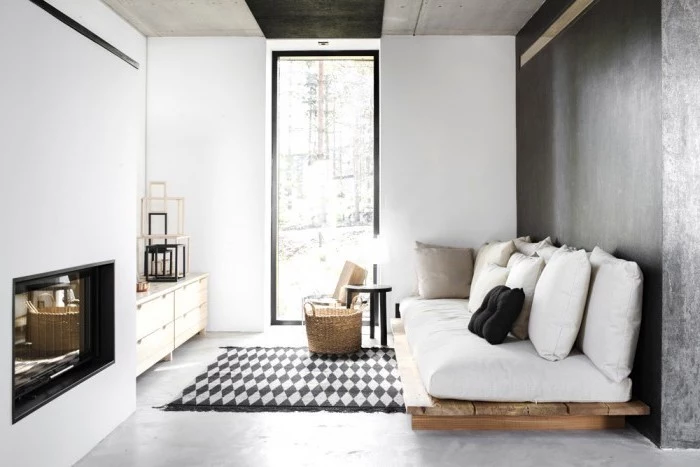
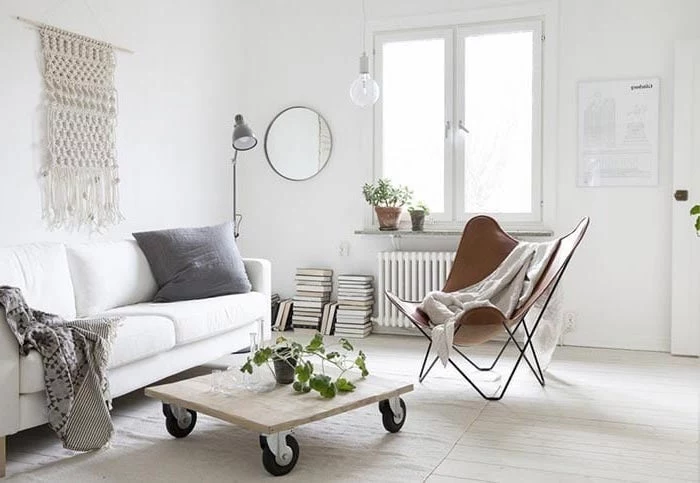
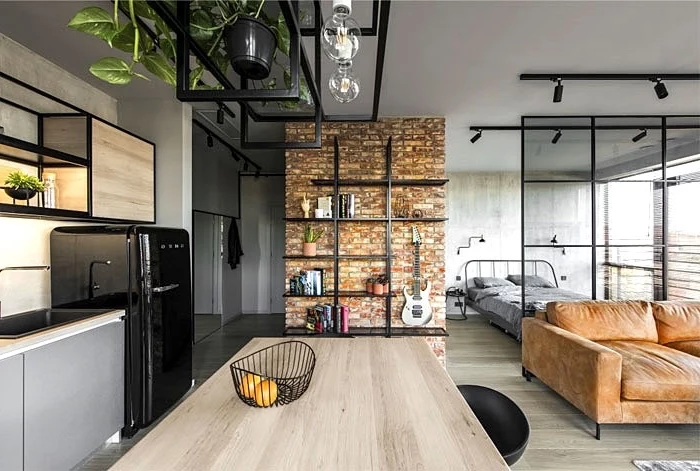
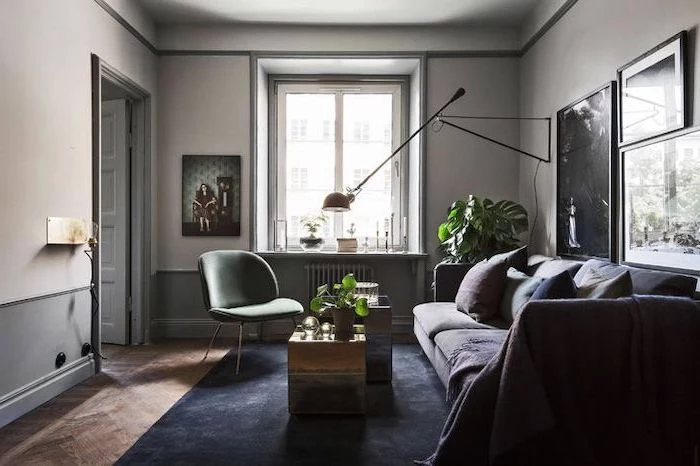
Embrace biophilia, the concept that humans have an innate need to connect with nature. Even in a tiny studio, adding plants can reduce stress and make the space feel more alive. If floor space is tight, think vertically. Use hanging planters, a wall-mounted planter system, or place a few small pots of herbs on a kitchen windowsill. Snake plants and ZZ plants are great low-light, low-maintenance options.
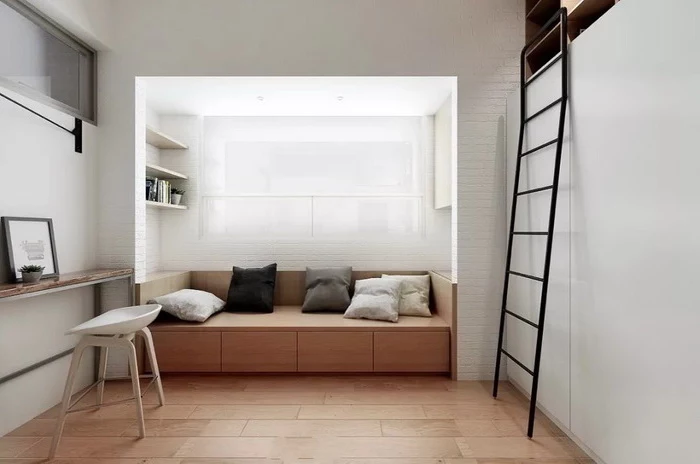
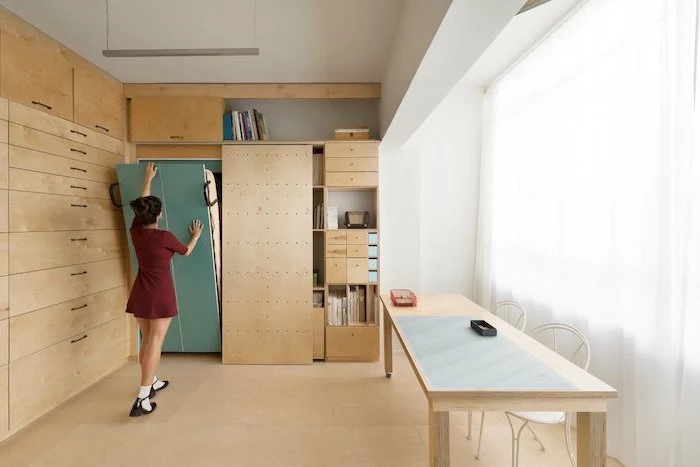
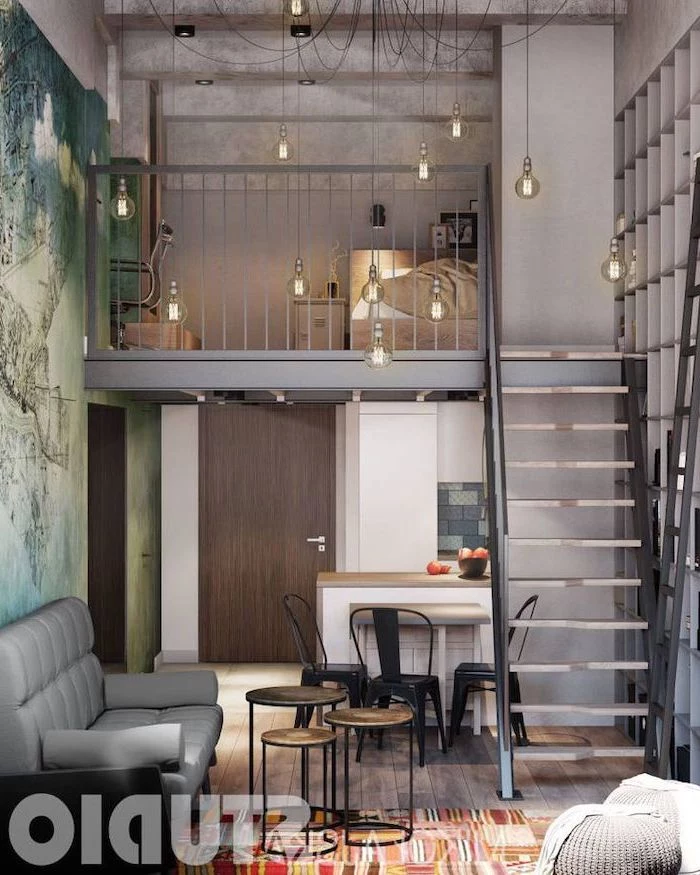
According to a 2018 study published in the ‘Building and Environment’ journal, occupants with a clear view of outdoor greenery from their workspace reported 19% lower levels of stress.
If you have a window, don’t block it with a bulky piece of furniture. Arrange your layout to maximize both the light and the view. If you’re lucky enough to have a good one, make it the focal point of the room. It’s a free, dynamic piece of art.
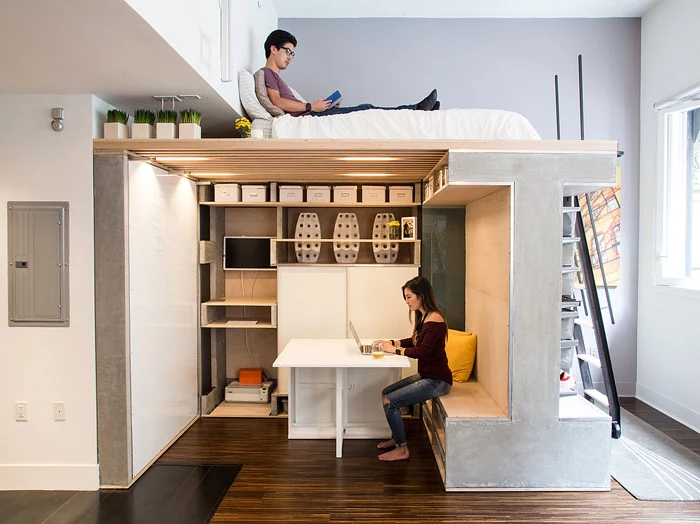
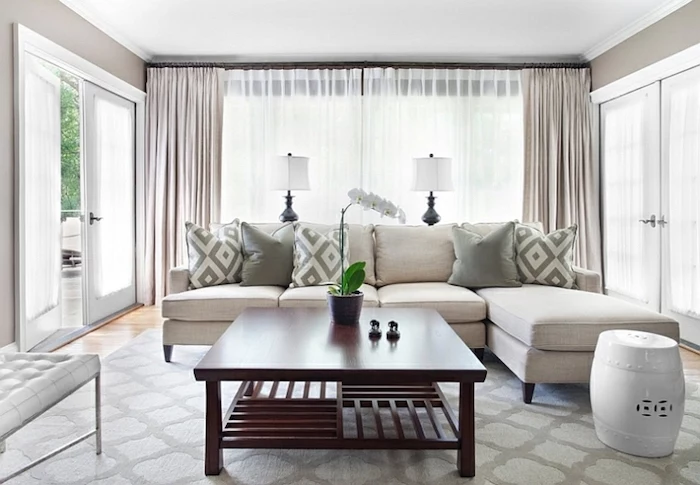
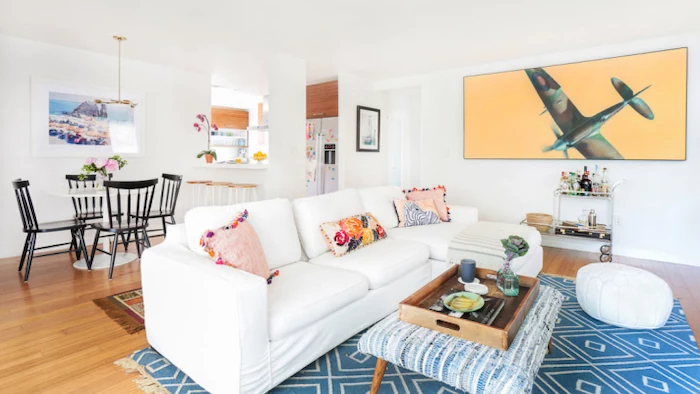
Measure twice, buy once. This is the unbreakable rule of small-space decorating. Before you fall in love with a sofa or bookshelf, map it out on your floor with painter’s tape. This helps you visualize not just if it fits, but how it impacts traffic flow and the space around it. An inch can make the difference between a functional layout and a frustrating obstacle course.
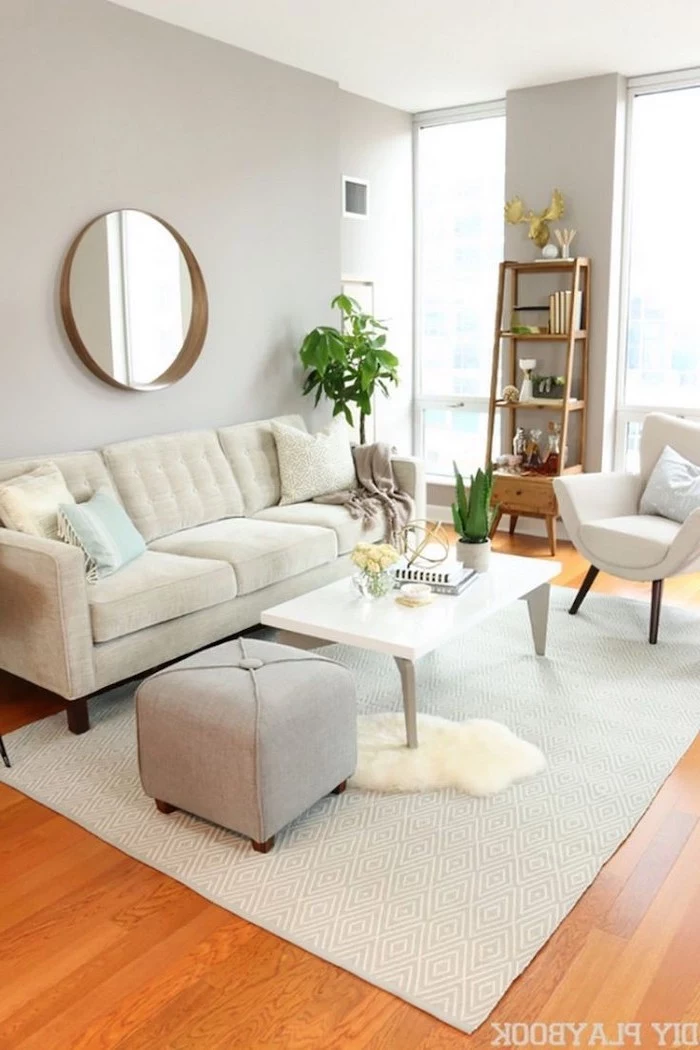
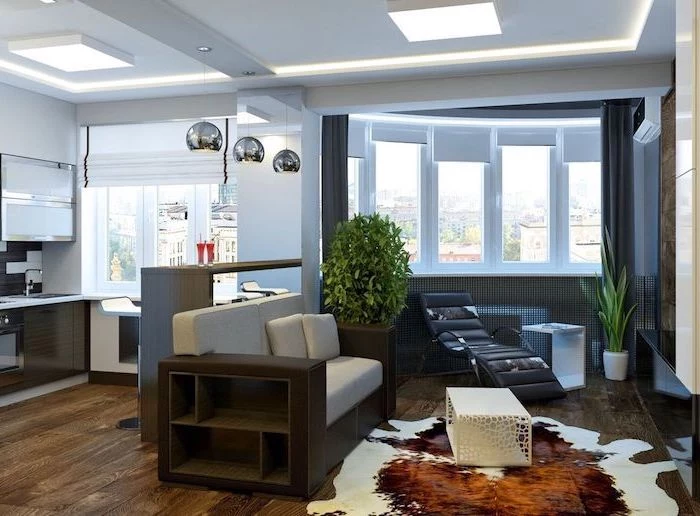
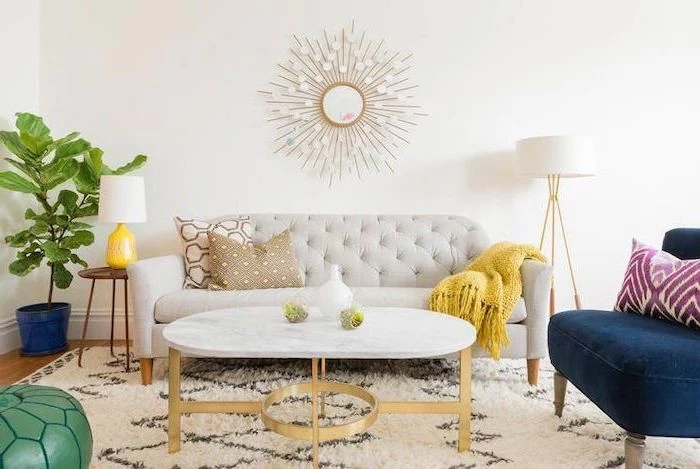
- A proper dining spot.
- A functional work-from-home surface.
- A spacious food prep area.
The answer? A convertible table. A wall-mounted drop-leaf table (like IKEA’s NORBERG) takes up virtually no space when folded down but provides a generous surface when needed. It’s far more versatile than a traditional dining table in a single-room layout.
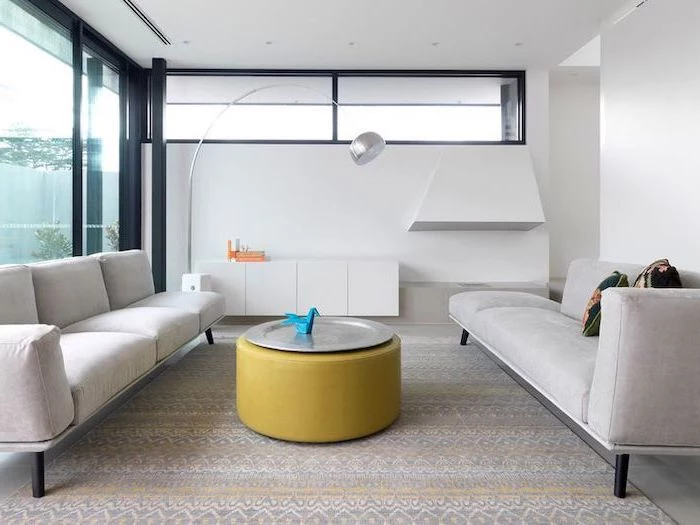
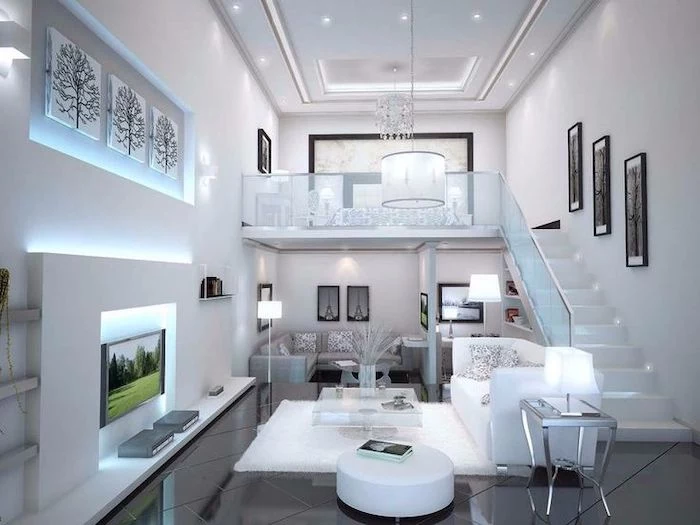
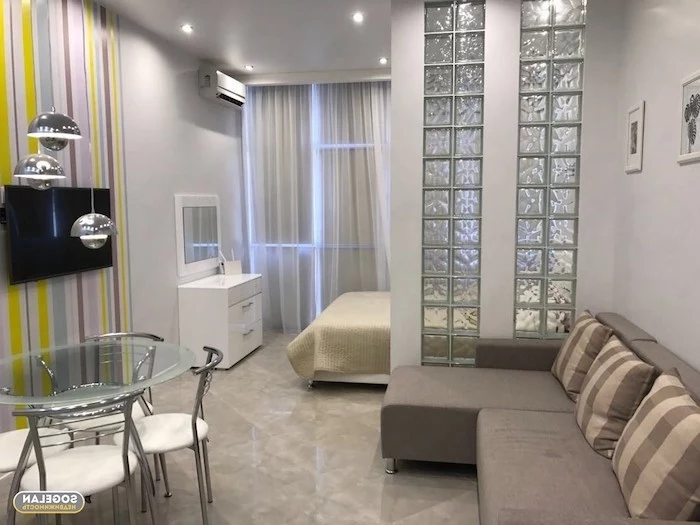
My desk is in my living room. How do I keep it from looking so… corporate?
Integrate it. Choose a desk that matches your other furniture in style and material—a slim wooden desk looks more like a console table than office furniture. Invest in beautiful storage boxes to hide papers. Opt for a stylish chair that could double as an accent chair. Finally, use a laptop instead of a desktop and put it away in a drawer at the end of the day to reclaim your living space completely.
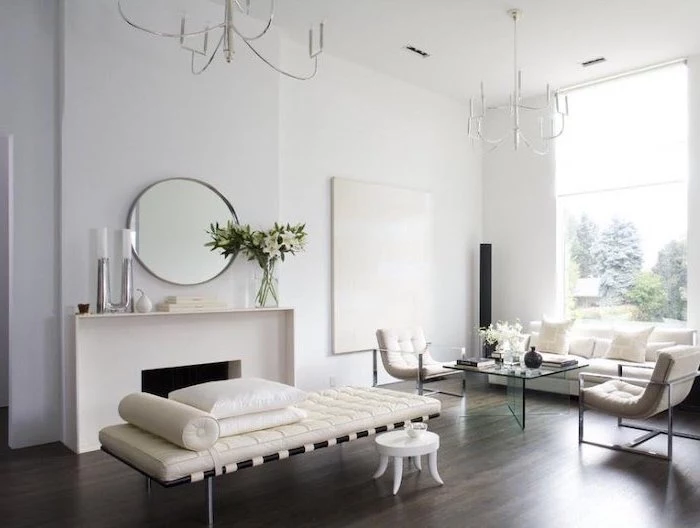
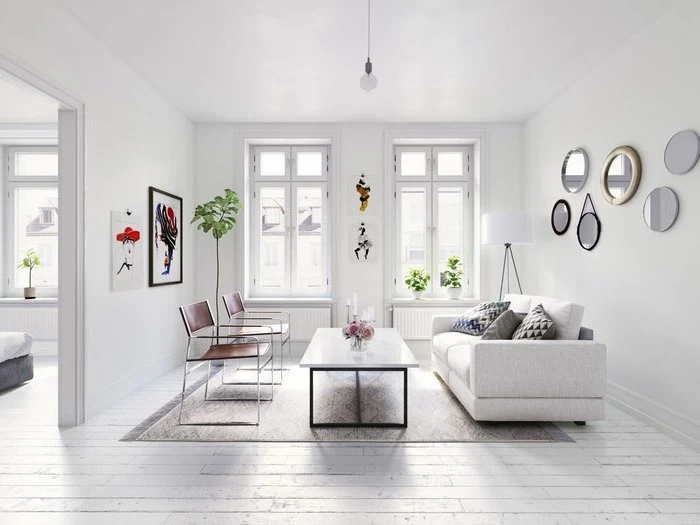
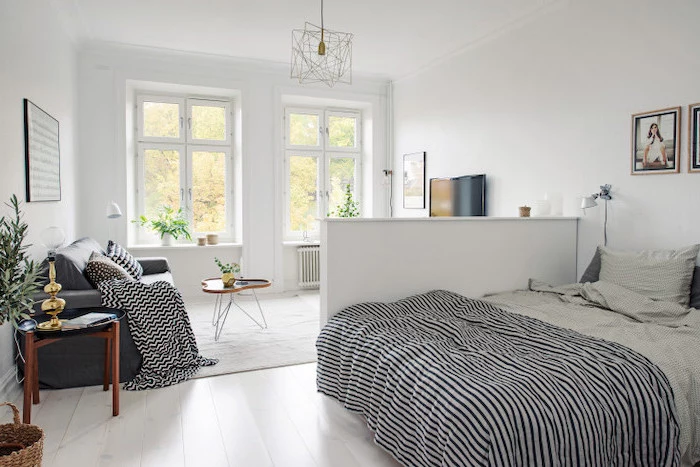
Don’t forget to declutter your tech. In a studio, visual noise is just as disruptive as physical clutter.
- Consolidate charging cables into one designated station.
- Use an app like LastPass to eliminate the need for notebooks full of passwords.
- Scan important documents and save them to the cloud to get rid of paper files.
- Choose a smart speaker like a Google Nest Mini or Amazon Echo Dot to replace a bulky old stereo system.
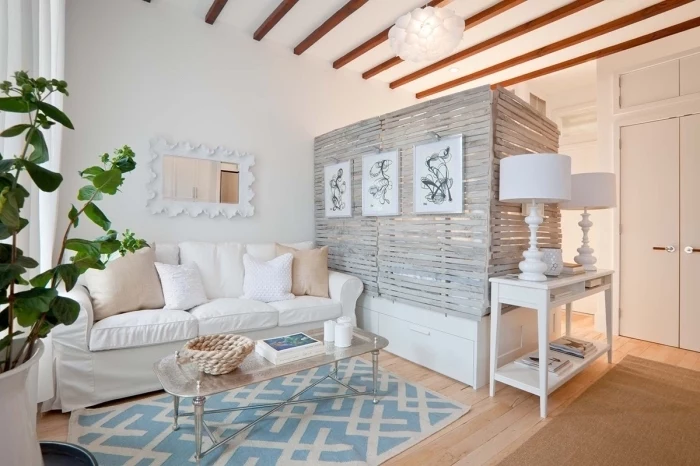
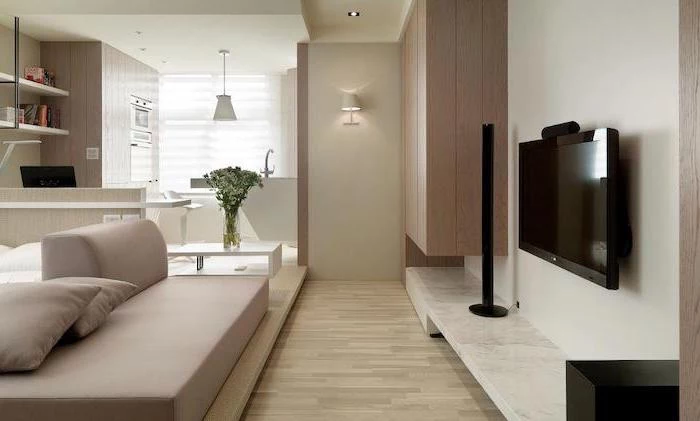
Fact: The human eye perceives rooms with lighter-colored floors and ceilings as being more spacious.
While the article talks about wall paint, don’t underestimate your ‘fifth and sixth walls’. If you have dark floors, a large, light-colored rug is a must. And always, always paint the ceiling a bright, clean white (or a shade even lighter than your walls) to give the illusion of height and airiness. A dark ceiling will feel like it’s pressing down on you.

